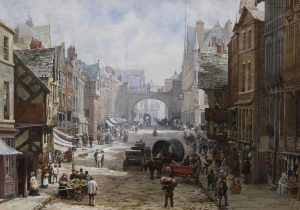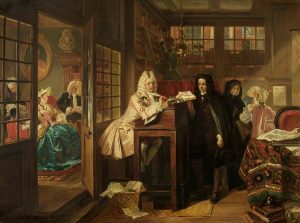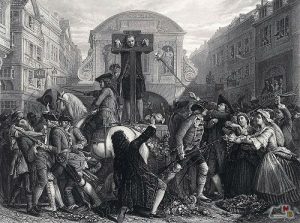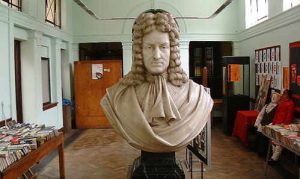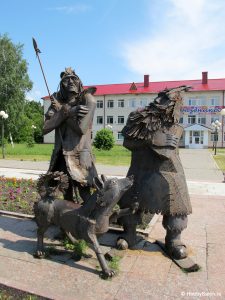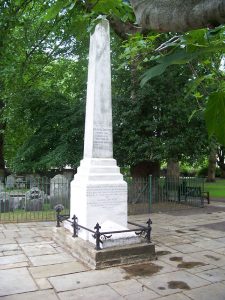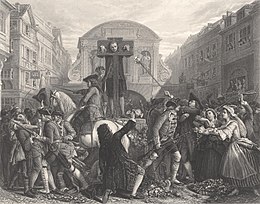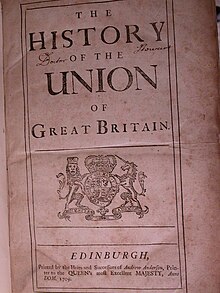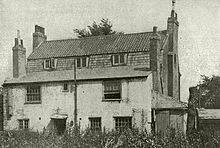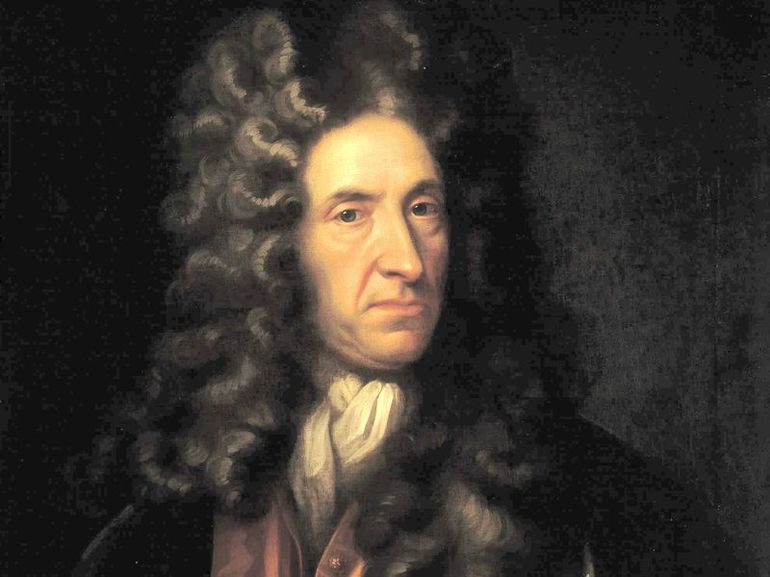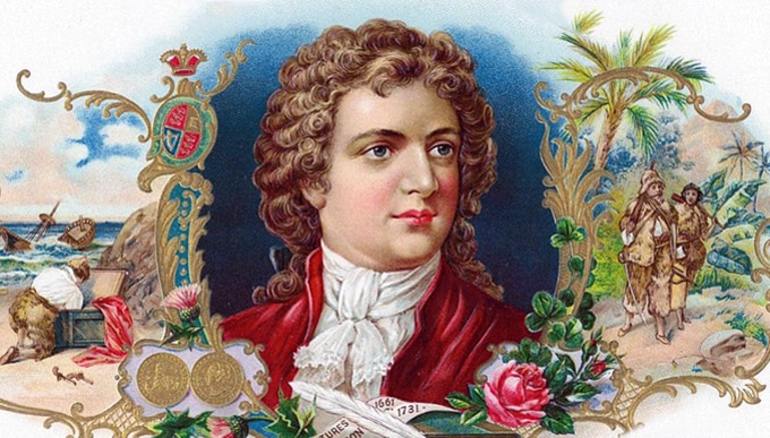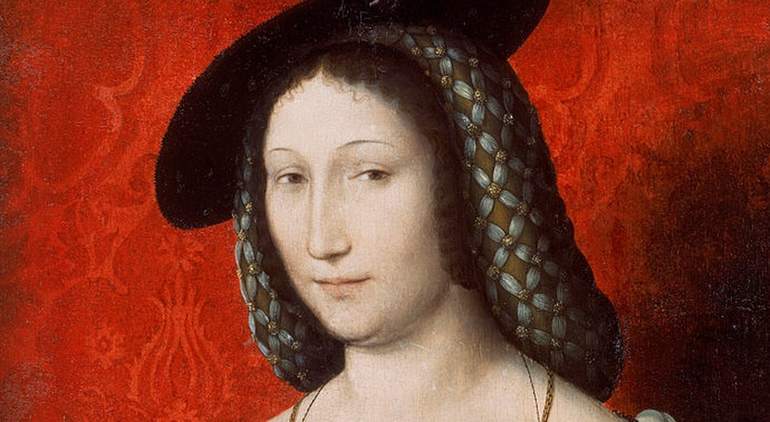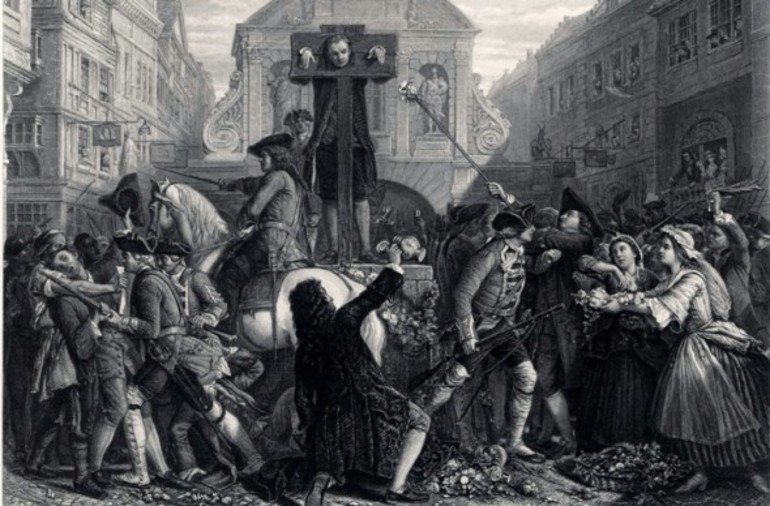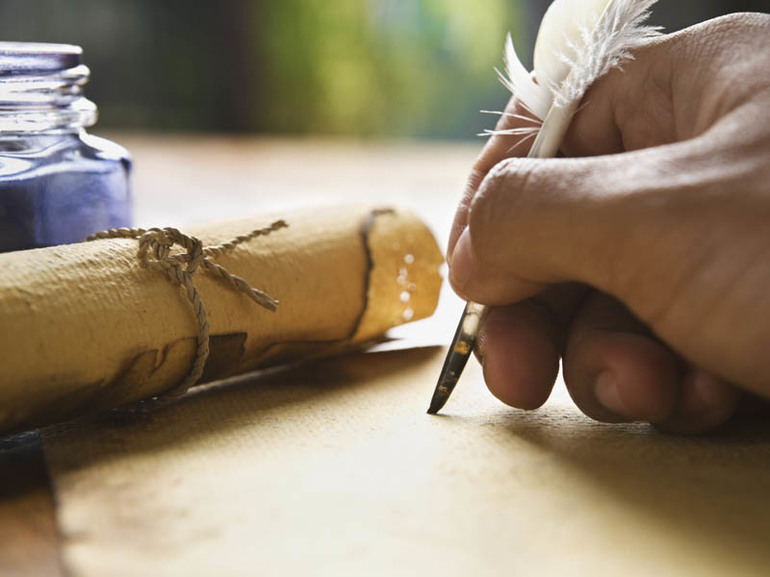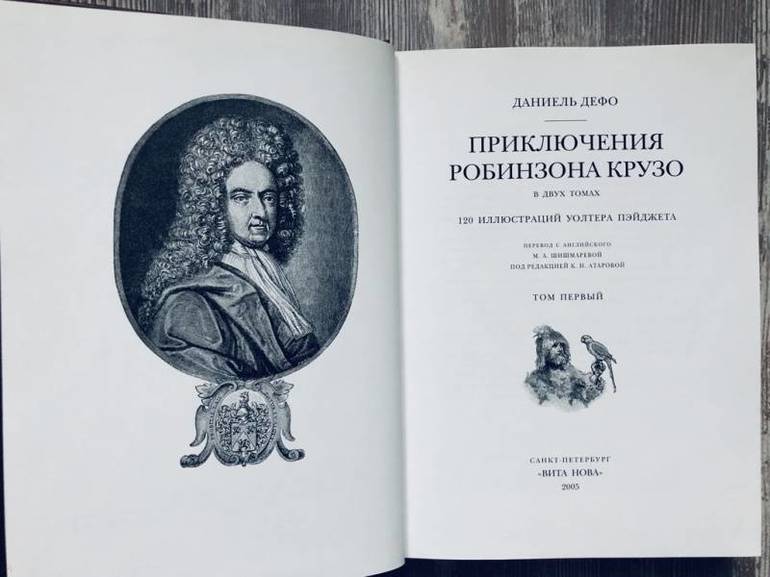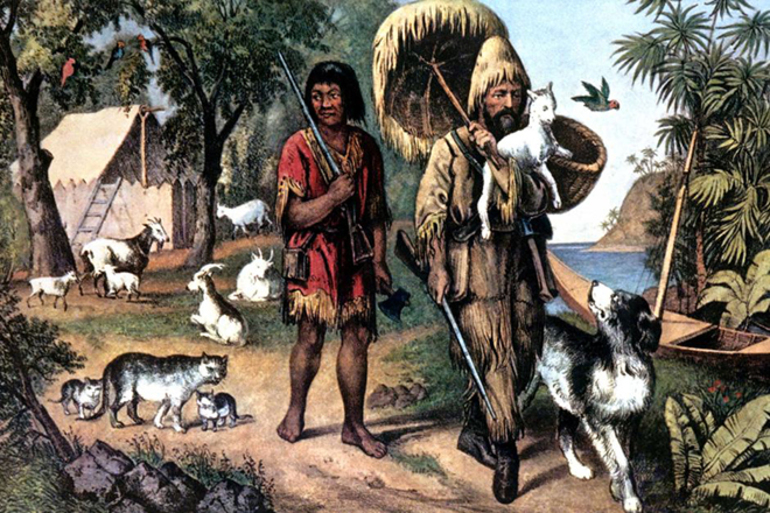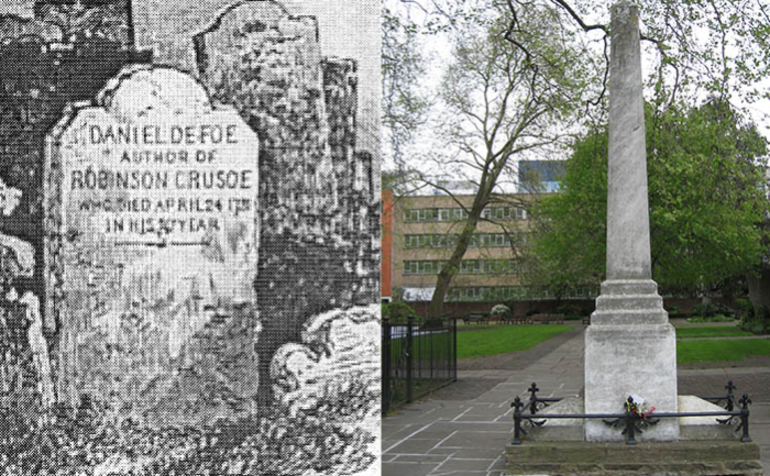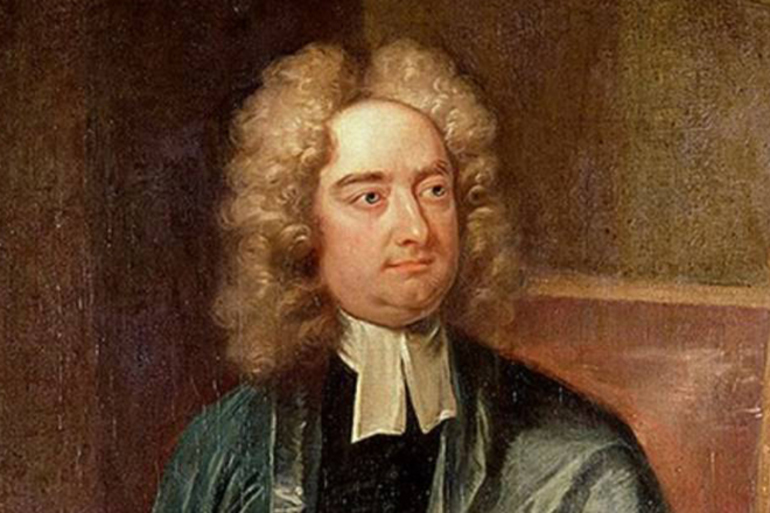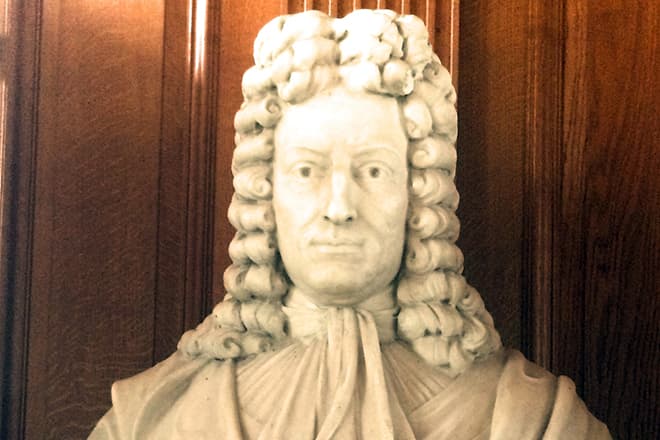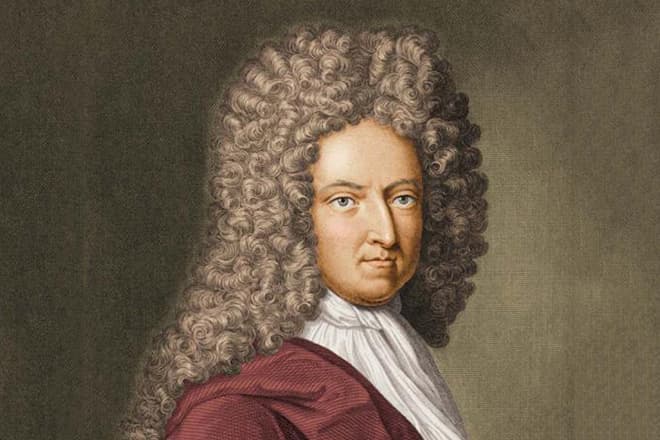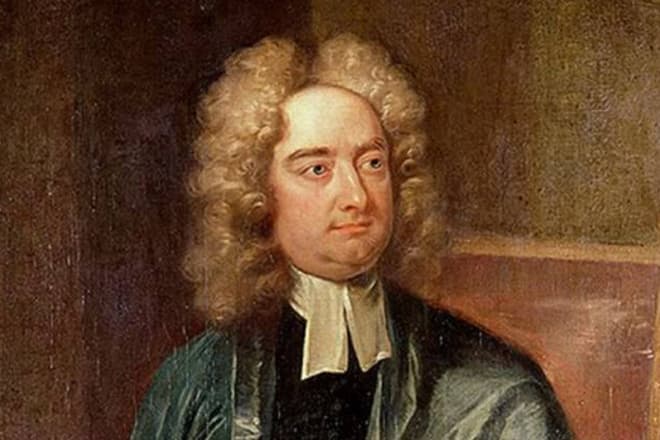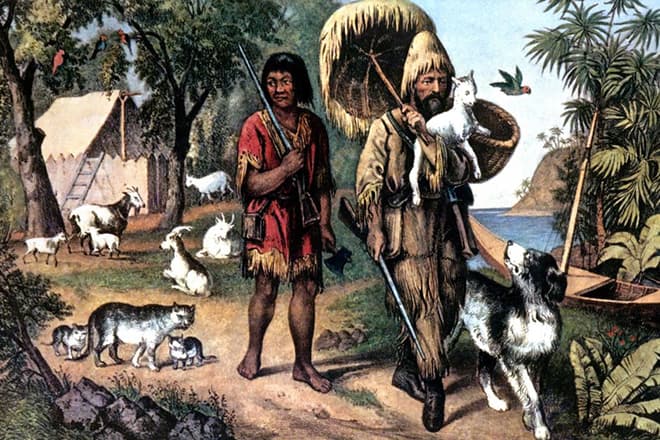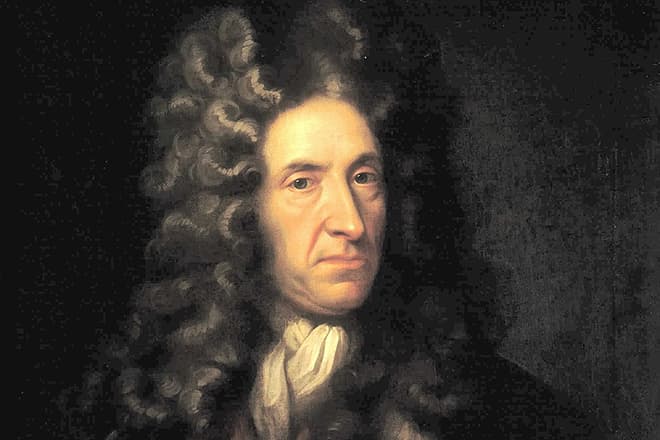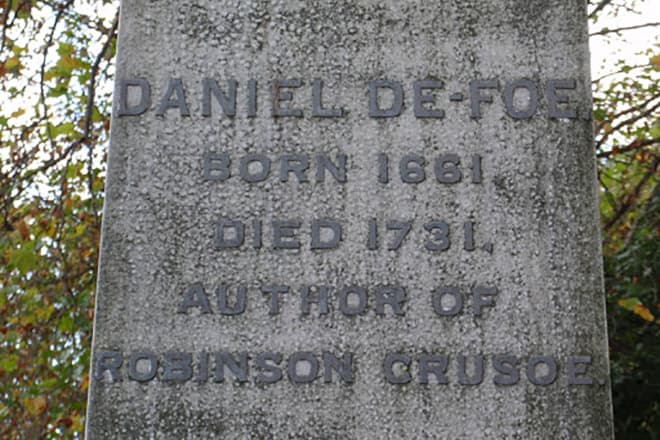Даниель Дефо — биография
Даниель Дефо — английский писатель, публицист. Он популяризовал жанр романа в Великобритании. Является основоположником экономической журналистики. Мировую известность ему принёс роман «Робинзон Крузо».
Даниеля Дефо можно назвать авантюристом. Его жизнь насыщена разнообразными событиями. Даниель успел повоевать, стать успешным бизнесменом, потом разориться, побывать во многих странах, заняться политикой, посидеть в тюрьме, стать шпионом, а потом написать роман, который принесёт ему мировую известность, и спустя 300 лет после выхода первого издания его будут любить и читать взрослые и дети по всему миру. Снимут множество фильмов, появится новое направление в литературе названное «робинзоадой». Даниель Дефо написал около 500 книг, журналов и памфлетов, темой которых стала политика и психология, обсуждал с читателем религию и тонкости брака, делился секретами экономики и освещал криминал.
Детство и юность
За давностью лет, точной даты рождения писателя нет, существует лишь примерная цифра 1660 год. Даниель родился в вполне благополучной и обеспеченной семье, в доме царила религиозная атмосфера, так как родители были набожными пресвитерианцами. Его отец имел торговую лавку, и занимался продажей мяса, а также у них был небольшой свечной заводик.
Настоящая фамилия писателя звучала иначе, Даниель Фо. Родители мечтали, что их сын станет пастором, для этого они отправили своего отпрыска учиться в духовную семинарию. По её окончанию Даниель продолжил обучение, теперь он учится в протестантской академии, которая располагалась в Стоук-Ньюингтоне. Учеником он был прилежным, особенно ему давались языки и классическая литература. Молодой человек превосходно осваивает латынь и греческий.
Торговец, писатель, шпион
Ещё во время обучения он уже знает, что пастором ему не быть. Коммерция очень увлекала юношу. Родитель принимает решение сына стать торговцем, для этого сразу после обучения Даниель устаивается на работу в контору чулочной фабрики. На этот момент ему едва исполнилось 19 лет. Даниель с упорством осваивает бухгалтерию, параллельно он ещё трудится и в чулочной лавке. Позднее его назначают приказчиком у оптового чулочного торговца. По делам конторы ему теперь часто приходится покидать родину. Он побывал по торговым делам в Испании, Португалии и Франции. Эти поездки расширили его кругозор, он усовершенствовал свои знания в языках, а самое главное он знакомился с жизнью людей, проживающих в Европе.
К середине 1680 годов Дефо считает, что он готов к самостоятельному ведению бизнеса и открывает собственную чулочную фабрику в Корнхилле, которая успешно работала и приносила хорошую прибыль целых 10 лет. Но потом обанкротилась. Дефо поступает управляющим на кирпичный завод, затем становится и его владельцем, но и это предприятие терпит крах. Он торгует табаком и строительными материалами.
Но все не ладится. Ему не раз говорили, что он пускается в очень рисковые и сомнительные предприятия, результатом которых становилось разорение. Но у Дефо своё виденье в бизнесе. Каждый раз ему удавалось найти верное решение и вернуть хотя бы часть потерянных денег.
Он поддерживает восстания герцога Манмута, принимает участие в сражении при Седжмуре, которое состоялось 6 июля 1685 года. Мятежники его проигрывают, сам герцог был казнён, а вот Даниелю чудом удалось спастись, и он сумел скрыться.
1697 год можно назвать началом его творческого пути. В этот год он напишет «Опыт о проектах», которое станет его первым произведением. Двумя годами позже его имя стало известно благодаря публикации сатирического памфлета в стихах «Чистокровный англичанин», в нём он высмеивает ксенофобию. Даниель являлся ярым защитником реформы и революции.
Но на этом интересы Даниеля не ограничивались. Ему была интересна политика. В 1688 году Вильгельм Оранский переходит границы Англии, и Даниель сразу присоединился к его армии. Он поддерживал планы короля Вильгельма. В это время он пишет несколько замечательных произведений, одними из которых являются «Защитительное слово бедняка» и «Прирождённый англичанин».
Начинающий писатель присваивает сам себе дворянское происхождение, придумывает фамильный герб, на котором разместились три грифона и лилии и к своей простонародной фамилии добавляет частицу «де». Затем Де Фо сливается в одно слово.
Король Вильгельм замечает Даниеля, он приглашает талантливого писателя во дворец. Жизнь Дефо резко меняется. Король предлагает ему писать политические памфлеты. Есть версии, что он смог приблизиться к монарху настолько, что Вильгельм пользовался его советами. Но после его смерти, и восшествию на престол Анны Стюарт, жизнь опять делает кульбит. Он по-прежнему при дворе, но не сразу разбирается в новых веяньях и порядках установленных монаршей особой.
В 1702 году он пишет памфлет под названием «Кратчайшая расправа с диссентерами», скрывая своё имя. Изначально парламентарии, обрадовались выходу столь нужного произведения, в котором автор советует чинить расправу над протестантами ссылая их на галеры, но затем они понимают, что он просто смеётся над ними. Литераторы назвали это сочинение событием столетия. Этот текст взбудоражил общественность и как следствие памфлетист был объявлен в розыск. Только через полгода стало известно, кто это написал.
Когда выяснился кто автор, то реакционеры решили предать Дефо суду. Даниель предпочёл скрыться, но позднее всё же решил вернуться на «милость правительства». Его приговаривают к штрафу, троекратному стоянию у позорного столба, внести залог и заключение его в тюрьму на неопределённый срок, который зависит от милости королевы
Его препровождают в Ньюгейтскую тюрьму. Там Дефо имеет возможность писать, чем он собственно и занимается. Написанный им вовремя «Гимн позорному столбу» помогает ему избежать унижения, которым подвергались люди наказанные таким образом. Толпа, собравшаяся вокруг него, встретила его как героя и аплодировала ему. Там же, в тюрьме, он стал издавать газету, благодаря этому событию Дефо стали считать родоначальником английской периодической печати.
Непомерные долги вынуждают литератора согласиться на работу шпиона, Даниель начинает работать на британское правительство. Он пишет выгодные для власти тексты, которые был обязан показывать для проверки. Ещё работает тайным агентом в Шотландии, и сообщает англичанам о замыслах оппозиции, сведения о которых он добывал в различных издательствах, так же своими публикациями он должен влиять на умонастроения шотландцев.
Получив согласие на эту работу, правительство уплатило за него штраф, а голодающая семья получила средства на существование. Свои публикации он должен был печатать в газете «Обозреватель», которая принадлежала английским властям.
Могут быть знакомы
«Робинзон Крузо»
Наверняка наши современники и не вспомнили бы, что когда-то жил некий Даниель Дефо, если бы он не написал роман, который сделал его знаменитым не только в Великобритании, но и по всему миру. Три столетия люди с увлечением читают эту книгу. История моряка, из Йорка, который после кораблекрушения попадает на необитаемый остров впервые была опубликована в 1719 году.
Идея написания этого романа пришла к 59-ти летнему Дефо после прочтения им заметки о шотландском мореплавателе, Александре Селькирке, который на необитаемом, тихоокеанском острове прожил четыре года. Потерянного моряка обнаружило судно Вудс Роджерс.
Появляющиеся немного позднее очерки об этом событии, которое произошло в 1704 году, ещё больше подогрели интерес Даниеля к этой теме. И он решает написать свою история отшельника. Дефо дополняет детали, увеличивает его проживание на острове до 28 лет, и превращает в увлекательнейший приключенческий роман. Книгу «Робинзон Крузо» можно назвать гимном цивилизации. Автор отразил своеобразную ретроспективу пути, проделанного человечеством. Главный герой, Робинзон Крузо от собирательства и охоты, проходит путь к прогрессу, он начинает заниматься земледелием и скотоводством, и конечно ремеслом.
Вышедшая книга моментально стала популярна. Успех романа был просто ошеломительным. Автор решается написать продолжении книги «Дальнейшие приключения Робинзона Крузо», но вторая часть оказалась менее интересной, но это не отменяет того факта, что она пользовалась большим спросом. Герой нового романа живёт в Великой Татарии, эту страну Дефо придумывает самостоятельно, но он подразумевает земли России, Монголии и Татарстана.
А следом выходит и третья часть, сравнить её по успеху можно только со второй книгой. Примечательно, что Даниель никогда не был в России, хотя во второй части он пишет про приключения Крузо в Сибири и Архангельске. И только через 100 лет книга попадает к нам, в Россию, и ещё через сто лет обретает массового читателя.
Даниелем Дефо написано ещё много увлекательной литературы. Как правило его герои всегда попадают в неприятности и с энтузиазмом потом их преодолевают. У них бесконечные приключения, которые захватывают читателя с первых страниц. Умение Даниеля Дефо писать лёгким стилем с интересным сюжетом с каждым днём только прибавляет ему количество поклонников по всему миру.
Опубликованный в 1720 годах приключенческий роман «Всеобщая история пиратства» стала не менее популярна среди читателей. В этот ряд можно поставить как приключенческие романы, так и исторические «Радости и горести Моль Флендерс» и «Дневник чумного года», «История полковника Джека», «Счастливая куртизанка, или Роксана», «Путешествие Англией и Шотландией».
Личная жизнь
Супругой писателя стала Мэри Таффли, в 1684 году. Девушка была из обеспеченной семьи, и получила немалое приданное. Но всего через восемь лет все четыре тысячи фунтов и плюс сбережения самого Даниеля были поглощены банкротством.
Семья Дефо была многодетной. У них родилось восемь детей. Назвать жизнь семьи безоблачной и счастливой нельзя. Преследование властей и постоянные требования кредиторов здорово омрачали им жизнь. Жильё они имели в неблагополучном районе Минт, затем перебрались в Бристоль. Даниель Дефо мог выйти из своего дома только в воскресенье, потому, что по этим дням должников не арестовывали.
Смерть
В последние годы жизни, финансовое положение только ухудшилось, чтобы как-то выжить Даниель обманул своего издателя, который впоследствии превратил его последний год жизни в сущий ад. Писателю пришлось покинуть дом и семью и начать скрываться. Он переезжал из города в город, а когда однажды обманутый издатель настиг его, то хотел даже проколоть его шпагой, но получил достойный отпор от 70-летнего Дефо, который его обезоружил.
Постоянные угрозы, и безденежье заставляют писателя скрываться под чужими фамилиями, меняя города и квартиры. В 1731 году он снимает комнату, в дальнем районе Лондона, в которой он и умер 24 апреля, этого же года. Ни жены, ни детей никого рядом не было. Все дети были заняты собой, сыновья занимались торговлей, дочери вышли замуж и имели уже свои семьи. Отыскать своего отца в трущобах никто не спешил.
Хоронила писателя хозяйка квартиры, она продала оставшиеся вещи и возместила себе убытки по похоронам. Позднее пресса вскользь осветила смерть Дефо, где-то даже помелькал сарказм его назвали «величайшим гражданином республики Граб-стрит», улицу где обычно собирались сочинители-неудачники, не умеющие писать достойно.
На месте захоронения Даниеля Дефо была поставлена белая плита, но вскоре она заросла травой, а потом и вовсе раскололась. Но через сто лет в 1870 году, британский таблоид обратился к английской детворе с просьбой пожертвовать какую-нибудь сумму на памятник писателю. Тысячи почитателей его романов отозвались на эту просьбу. И теперь на могиле Даниеля Дефо стоит гранитный монумент, на котором написаны слова: «В память автора «Робинзона Крузо».
Ссылки
- Страница в Википедии
Для нас важна актуальность и достоверность информации. Если вы обнаружили ошибку или неточность, пожалуйста, сообщите нам. Выделите ошибку и нажмите сочетание клавиш Ctrl+Enter.
 Роль и место в литературе
Роль и место в литературе
Даниэль Дефо – выдающийся представитель эпохи Просвещения. Кроме знаменитого романа «Приключения Робинзона» автор оставил наследие в виде полутысячи художественных и публицистических текстов. Все они стали известными не только в Англии, но и во всем мире.
Влияние Д. Дефо на европейскую литературу не ограничивается его самым известным романом. Он привнес в литературу тему одиночества человека на фоне природы, что приводит к духовному совершенствованию и раскрепощению.
Лондон времен Даниеля Дефо
Помимо написания произведений Даниэль Дефо занимался предпринимательством, издательской деятельностью, хорошо разбирался в политике. Обладая талантом публициста, он своими памфлетами затрагивал острые темы общественной и политической жизни Англии. Выступал в защиту свободы слова и здравомыслия.
Его публицистика имела воздействие и на правительство, и на короля, и на простой народ. Созданные им художественные произведения несли просветительские идеи, характерные для многих творений той эпохи.
Происхождение и ранние годы
Даниель Дефо родился в Лондоне, в 1660 году. Точная дата рождения остается неизвестной, так как церковные записи были уничтожены пожаром. Его отец носил имя Джеймс Фо и был довольно зажиточным торговцем. Мать ушла из жизни, когда мальчику было всего 8 лет. Спустя годы, уже, будучи взрослым, Даниэль, добавив две буквы к фамилии, превратил ее в свой литературный псевдоним Дефо, под которым его знает весь мир.
Образование
Отец готовил мальчика к церковной карьере и в возрасте 14 лет отдал его в семинарию, желая видеть сына священнослужителем. Даниэль был способным и окончил не только школу, но и академию. Во время обучения у него появился интерес к классической литературе и языкам. Еще будучи студентом, он уже писал стихи на религиозные темы и овладел несколькими иностранными языками.
Издательство отклоняет рукопись “Робинзон Крузо”
Однако, перспективы духовной карьеры вскоре уступили место более реальным коммерческим идеям, и несостоявшийся священник занялся торговлей. Врожденная коммерческая жилка позволила ему в двадцатилетнем возрасте открыть чулочное производство. Это предприятие в течение 10 лет обеспечивало ему хороший доход. Позже он торговал в странах Европы строительными материалами, вином и табачными изделиями.
Благодаря торговой деятельности, Даниэль получил возможность много и долго путешествовать. Он побывал во всех странах Пиренейского полуострова, где знакомился с местной культурой, литературой и подтягивал знания в языках.
Творчество
Жизнь Даниэля была разнообразной и насыщенной. В молодом возрасте он начал интересоваться политикой, и был участником восстания против короля Якова II. За участие в мятеже подвергся гонениям и скрывался в разных городах от тюремного преследования.
После изгнания Якова II на престол вступил Вильгельм III, что позволило буржуазии занять свои позиции наравне с аристократией. Даниэль возвращается, чтобы заняться своими коммерческими делами. В это же время его начинает интересовать журналистика.
Одно за другим появляются его публицистические произведения. Он не занимал каких-либо государственных должностей но, при этом, имел влияние на правительство.
Дефо у позорного столба
В 1701 г. Даниэль Дефо сочинил памфлет «Чистокровный англичанин», в котором подверг критике аристократию. 80 тысяч экземпляров моментально были распроданы. Но популярность обернулась наказанием в виде позорного столба и огромного штрафа. Его гражданская и деловая репутация пошатнулись, и его коммерческая деятельность по производству черепицы была свернута.
На помощь Дефо пришел министр Роберт Харли. В 1704 году он дал ему работу в периодическом издании «Ревю». Дефо до 1713 года работал журналистом и редактором, а его комментарии политического характера еще долго оставались самыми популярными.
Дефо продолжает упорно трудиться в сфере журналистики. Одновременно из-под его пера выходят и художественные произведения. Его замечательный роман «Жизнь и удивительные приключения Робинзона Крузо» вышел в свет в 1719 году. На волне ошеломительного успеха автор пишет «Дальнейшие приключения Робинзона Крузо» и, спустя год – еще одно продолжение. Романы прохладно были приняты публикой, и не приблизились по популярности и успеху к первой части.
Перу Даниэля Дефо принадлежит более 500 произведений разных жанров. Это романы «Радости и горести Моль Флендерс», «Счастливая куртизанка, или Роксана», «Жизнь, приключения и пиратские подвиги прославленного капитана Синглтона», а также труды «Морской торговый атлас», «Путешествие по всему острову Великобритания» и многие другие.
Наиболее значительные произведения
Лучшим воплощением литературного таланта Дефо стал роман «Робинзон Крузо». Автор написал его в возрасте 59 лет. Основанием для написания романа стало реальное происшествие 1704 года, когда моряк из Шотландии в одиночку провел на незнакомом острове 4 года.
Бюст Дефо в музее
Основной тезис, на котором базируется роман в том, чтобы показать человека разумным социальным существом. Поэтому автор строит жизнь своего героя по законам человеческой цивилизации. У Робинзона строгий ежедневный распорядок: утренняя молитва, затем добывание пищи и ее приготовление. Остальное время было занято изготовлением различных предметов, строительством или просто отдыхом.
Большой интерес вызывает и другой персонаж – слуга Робинзона Пятница. Спасенный Робинзоном, дикарь по рождению, он в благодарность обещает с преданностью служить новому хозяину. Его среда обитания – природа и он никогда не прикасался к цивилизации. На примере образа Пятницы Дефо показал влияние цивилизации на личность.
Скульптура Робинзон и Пятница в Тобольске
«Всеобщая история пиратства» – эту книгу можно назвать самой знаменитой в данном жанре. Она была издана под вымышленным именем капитана Чарльза Джонсона и ее по праву называют «библией пиратства». События, описанные в ней, послужили источником для многочисленных фильмов и романов.
«Дневник Чумного Года» автор написал на основе детских воспоминаний о страшном нашествии чумы. Будучи пятилетним мальчиком, он стал свидетелем многочисленных смертей своих соседей, друзей родителей и всех, кто не смог уберечься от эпидемии.
Последние годы
Последние годы жизни писателя были омрачены острой нуждой. Отчаявшись, он принимает решение обмануть своего издателя и пускается в бега. Через некоторое время издателю удалось вычислить местонахождение Дефо, и даже напасть на него со шпагой. Но писателю удалось увернуться.
Постоянные скитания привели его в отдаленный район Лондона, где он скончался в съемной квартире 24 апреля 1731 года. Похоронен он был квартирной хозяйкой на простом кладбище.
Известие о смерти писателя не всколыхнуло общество, в прессе появлялись некрологи, полные сарказма. Могила его, заросшая травой, была неухоженной, и лишь через 100 лет на ее месте воздвигли памятник великому писателю.
Хронологическая таблица (по датам)
| Год (годы) | Событие |
| 1660 | Рождение писателя |
| 1673 | Поступление в лондонскую академию |
| 1683 | Открытие собственного магазина |
| 1684 | Вступление в брак |
| 1685 | Участие в мятеже против короля |
| 1692 | Банкротство и закрытие коммерческого предприятия |
| 1701 | Начало литературной карьеры |
| 1704-1713 | Работа в газете «Обозреватель» |
| 1722 | «Радости и горести Молль Флендерс» |
| 1722 | «История полковника Джека» |
| 1722 | «Дневник чумного года» |
| 1724 | Издается «Робинзон Крузо» |
| 1724 | «Всеобщая история пиратства» |
| 1731 | Год смерти Д. Дефо |
Интересные факты
- роман о Робинзоне Крузо может побить рекорд по количеству экранизаций;
- все коммерческие начинания Дефо всегда оканчивались банкротством;
- собравшиеся на площади забрасывали Дефо цветами во время его гражданской казни;
- продолжения «Робинзона Крузо» не имели успеха у читателей;
- первым переводчиком романа о Робинзоне был Лев Толстой;
- некоторые называют Дефо основателем британской разведки;
- за свою литературную карьеру писатель пользовался 198 псевдонимами;
- после смерти писателя квартирная хозяйка распродала его вещи, чтобы компенсировать расходы на похороны
Увековечение памяти
Памятник на месте захоронения Дефо
В Лондоне на месте захоронения Д. Дефо установлен памятник.
Остров в Чили носит имя Робинзона Крузо.
В Шотландии и г. Тобольск установлены памятники Робинзону Крузо.
Ссылки
Памятники Робинзону Крузо
Остров Робинзона в Чили
«Чтобы помнили», страница о Д. Дефо с иллюстрациями
Место захоронения Д. Дефо
Ирина Зарицкая | Просмотров: 13.2k
Даниель Дефо (1660-1731) – разносторонний и плодотворный английский писатель и публицист. Считается, что именно он сделал популярным в Великобритании такой литературный жанр, как роман. В мире самым известным героем его произведений является Робинзон Крузо. Всего Дефо написал более 500 книг, журналов и памфлетов на самую разную тематику, начиная от политики с экономикой и заканчивая религией, психологией и семьёй. Он заложил основы экономической журналистики, считается основателем английской разведки.
Детские и юношеские годы
Родился Даниель Дефо около 1660 года недалеко от Лондона в небольшом местечке Криплгейте. Его отца звали Джей Фо, он был довольно состоятельным торговцем, продавал мясо и вдобавок к этому ещё имел небольшую свечную фабрику. И отец, и мать были ярыми диссидентами-пуританинами, то есть выступали против английской господствующей церкви.
Родители готовили Даниеля к пресвитерианскому пасторству, поэтому в возрасте 14 лет отдали его в духовную семинарию. После неё юноша окончил ещё Академию Мортона в Стоук-Ньюингтоне. Он, как примерный ученик, хорошо изучил греческий язык, латынь и классическую литературу, но всё это не было для молодого человека интересным. Его увлекала коммерция и торговое дело, этим Даниель готов был заниматься всю жизнь. Хотя всё равно он всегда вспоминал ньюингтонскую школу с теплотой за то, что она дала ему много необходимых знаний.
Торговля
В девятнадцатилетнем возрасте Дефо обучение завершил и, как советовал ему отец, начал коммерческую деятельность. В Лондоне имелась контора оптовой чулочной фирмы, работавшей с заграницей. Отец послал в эту контору Даниеля обучаться торговой практике и бухгалтерскому делу, учёбу юноша совмещал с работой приказчиком у чулочного торговца.
Обучение в конторе Дефо окончил в 1685 году и сразу же занялся оптовой чулочной торговлей в Корнхилле. Открытая им фирма просуществовала до 1695 года. Потом он занимался торговлей кирпичом и черепицей, винами и табаком. По долгу службы ему приходилось бывать в Португалии, Франции и Испании, где он знакомился с европейской жизнью, изучал иностранные языки.
Очень часто Даниель вступал в рискованные сделки, неоднократно бывал на грани банкротства, но всегда находил выход из сложившейся ситуации.
Политика
Помимо коммерции Даниеля всегда интересовала религиозная и политическая борьба. Например, в 1685 году он был участником восстания герцога Монмаута, который выступал против политики Якова II Стюарта. 6 июля 1685 года состоялось сражение при Седжмуре, мятежники его проиграли, власти тогда восстание задушили, герцога казнили, а сам Дефо едва сумел спрятаться от преследования.
Ещё в 1681 году он начал увлекаться поэзией, писал стихи на религиозные темы. А в 1687 году он написал свой первый памфлет, в котором рассуждал о свободе совести и обращался к его королевскому высочеству. Поводом послужила недавно подписанная декларация о прекращении действия карательных законов, принадлежавших к вероисповеданию. Это его первое литературное выступление охарактеризовало Дефо как хорошего писателя и зрелого политического деятеля, хотя ему было на то момент всего 26 лет. Однако многие его друзья не приняли такого выступления против королевской декларации. Это сильно разочаровало Дефо и он забросил свои литературные намерения, занялся снова исключительно торговлей.
Но через несколько лет Даниель вернулся к литературе. Он писал сатирические стихи и очерки, памфлеты и трактаты, в которых разоблачал несправедливые законы и призывал к реформам. Его сатира была очень популярна среди народа, и вскоре Дефо стал заметной политической личностью.
Когда к власти пришла королева Анна, за свои памфлеты Дефо попал в тюрьму и три раза был выставлен к позорному столбу.
Чтобы освободиться из тюрьмы, Даниелю пришлось пойти на сотрудничество с властью, он стал тайным агентом и в течение нескольких лет выполнял правительственные поручения.
Литература
Возраст Дефо приближался уже к 60 годам, когда он услышал реальную историю о том, как моряк из Шотландии Александр Селькирк попал на необитаемый остров Хуан Фернандес в Тихом океане. Он прожил там 4 года, пока его не обнаружил и не подобрал корабль, которым командовал Вудс Роджерс. Капитан Роджерс потом описал эти события в книге «Плавание вокруг мира». А вскоре за этим на глаза Дефо попался ещё и очерк Стиля «История Александра Селькирка». Даниель всерьёз заинтересовался этим шотландским моряком, и творческое сознание Дефо превратило уникальную историю в масштабное художественное произведение.
Ну, кто из нас, будучи совсем в юном возрасте, не зачитывался «Приключениями Робинзона Крузо», где главный герой в течение 28 лет проживал на безлюдном острове и сумел не только выжить, но и создать свой личный мир.
Успех этого романа был настолько феноменальным, что Даниель Дефо в скором времени взялся за его продолжение. В 1719 году увидел свет роман «Последующие приключения Робинзона Крузо», а ещё через год писатель сочинил «Серьезные размышления в течение жизни и удивительные приключения Робинзона Крузо с его виденьем ангельского мира». Но, надо сказать, что по популярности с первым романам последующие два не сравнить, такого читательского успеха они не имели.
Теперь уже Дефо посвящал всё своё время, а можно сказать, и жизнь только творчеству. Одно за другим выходят из-под его пера произведения:
- 1720 год – «Капитан Синглтон», «Мемуары кавалера»;
- 1722 год – «Полковник Джек» и «Молль Флендерс», «Дневник чумного года»;
- 1724 год – «Роксана»;
- 1726 год – «Путешествие Англией и Шотландией».
В его сочинениях в большей степени преобладали жанр авантюрных романов, историческая и приключенческая тематика. Также он много писал романов-мемуаров.
Последние годы жизни и смерть
Дефо был женат на Мэри Таффли, женщина родила писателю восьмерых детей, но получилось так, что умирал он в одиночестве.
Последний год жизни Даниеля Дефо оказался ужасным и мрачным. Его жестоко, хотя и вполне заслуженно, пытался наказать обманутый им издатель, он преследовал его, один раз напал со шпагой, но Дефо, несмотря на преклонный возраст, смог тогда обезоружить противника.
Эти постоянные угрозы и преследования в конце концов разбили болезненного старца, и он обезумел. Обманутый им человек грозился местью, и Даниель убежал от семьи, стал скрываться, назывался чужим именем, постоянно переезжал с места на место по разным городам Англии.
Вдоволь поскитавшись, в 1731 году Дефо вернулся в Англию и поселился в Мурфилде, самом отдалённом районе города. Здесь знаменитый создатель Робинзона Крузо умер в старости и одиночестве 26 апреля 1731 года.
О его смерти не знал никто из родственников, похоронами занималась квартирная хозяйка. Вещи, которые остались от Дефо, она продала на аукционе, чтобы возместить себе похоронные расходы.
|
Daniel Defoe |
|
|---|---|
 |
|
| Born | Daniel Foe c. 1660 London, England |
| Died | 24 April 1731 (aged 70) London, England |
| Resting place | Bunhill Fields |
| Occupation | Writer, journalist, merchant |
| Genre | Adventure |
| Spouse | Mary Tuffley |
Daniel Defoe (; born Daniel Foe; c. 1660 – 24 April 1731)[1] was an English writer, trader, journalist, pamphleteer, and spy. He is most famous for his novel Robinson Crusoe, published in 1719, which is claimed to be second only to the Bible in its number of translations.[2] He has been seen as one of the earliest proponents of the English novel, and helped to popularise the form in Britain with others such as Aphra Behn and Samuel Richardson.[3] Defoe wrote many political tracts, was often in trouble with the authorities, and spent a period in prison. Intellectuals and political leaders paid attention to his fresh ideas and sometimes consulted him.
Defoe was a prolific and versatile writer, producing more than three hundred works[4]—books, pamphlets, and journals — on diverse topics, including politics, crime, religion, marriage, psychology, and the supernatural. He was also a pioneer of business journalism[5] and economic journalism.[6]
Early life[edit]
Daniel Foe (his original name) was probably born in Fore Street in the parish of St Giles Cripplegate, London.[7] Defoe later added the aristocratic-sounding «De» to his name, and on occasion made the false claim of descent from a family named De Beau Faux.[8] «De» is also a common prefix in Flemish surnames.[9] His birthdate and birthplace are uncertain, and sources offer dates from 1659 to 1662, with the summer or early autumn of 1660 considered the most likely.[10] His father, James Foe, was a prosperous tallow chandler of Flemish descent,[11][12][a] and a member of the Worshipful Company of Butchers. In Defoe’s early childhood, he experienced some of the most unusual occurrences in English history: in 1665, 70,000 were killed by the Great Plague of London, and the next year, the Great Fire of London left only Defoe’s and two other houses standing in his neighbourhood.[16] In 1667, when he was probably about seven, a Dutch fleet sailed up the Medway via the River Thames and attacked the town of Chatham in the raid on the Medway. His mother, Alice, had died by the time he was about ten.[17][18]
Education[edit]
Defoe was educated at the Rev. James Fisher’s boarding school in Pixham Lane in Dorking, Surrey.[19] His parents were Presbyterian dissenters, and around the age of 14, he was sent to Charles Morton’s dissenting academy at Newington Green, then a village just north of London, where he is believed to have attended the Dissenting church there.[20][21] He lived on Church Street, Stoke Newington, at what is now nos. 95–103.[22] During this period, the English government persecuted those who chose to worship outside the Church of England.
Business career[edit]
Defoe entered the world of business as a general merchant, dealing at different times in hosiery, general woollen goods, and wine. His ambitions were great and he was able to buy a country estate and a ship (as well as civets to make perfume), though he was rarely out of debt. On 1 January 1684, Defoe married Mary Tuffley at St Botolph’s Aldgate.[23] She was the daughter of a London merchant, and brought with her a dowry of £3,700—a huge amount by the standards of the day. Given his debts and political difficulties, the marriage may have been troubled, but it lasted 47 years and produced eight children.[17]
In 1685, Defoe joined the ill-fated Monmouth Rebellion but gained a pardon, by which he escaped the Bloody Assizes of Judge George Jeffreys. Queen Mary and her husband William III were jointly crowned in 1689, and Defoe became one of William’s close allies and a secret agent.[17] Some of the new policies led to conflict with France, thus damaging prosperous trade relationships for Defoe.[17] In 1692, he was arrested for debts of £700 and, in the face of total debts that may have amounted to £17,000, was forced to declare bankruptcy. He died with little wealth and evidently embroiled in lawsuits with the royal treasury.[2]
Following his release from debtors’ prison, he probably travelled in Europe and Scotland,[24] and it may have been at this time that he traded wine to Cadiz, Porto and Lisbon. By 1695, he was back in England, now formally using the name «Defoe» and serving as a «commissioner of the glass duty», responsible for collecting taxes on bottles. In 1696, he ran a tile and brick factory in what is now Tilbury in Essex and lived in the parish of Chadwell St Mary.
Writing[edit]
As many as 545 titles have been attributed to Defoe, including satirical poems, political and religious pamphlets, and volumes.
Pamphleteering and prison[edit]
Defoe’s first notable publication was An Essay Upon Projects, a series of proposals for social and economic improvement, published in 1697. From 1697 to 1698, he defended the right of King William III to a standing army during disarmament, after the Treaty of Ryswick (1697) had ended the Nine Years’ War (1688–1697). His most successful poem, The True-Born Englishman (1701), defended William against xenophobic attacks from his political enemies in England, and English anti-immigration sentiments more generally. In 1701, Defoe presented the Legion’s Memorial to Robert Harley, then Speaker of the House of Commons—and his subsequent employer—while flanked by a guard of sixteen gentlemen of quality. It demanded the release of the Kentish petitioners, who had asked Parliament to support the king in an imminent war against France.
The death of William III in 1702 once again created a political upheaval, as the king was replaced by Queen Anne who immediately began her offensive against Nonconformists.[17] Defoe was a natural target, and his pamphleteering and political activities resulted in his arrest and placement in a pillory on 31 July 1703, principally on account of his December 1702 pamphlet entitled The Shortest-Way with the Dissenters; Or, Proposals for the Establishment of the Church, purporting to argue for their extermination.[25] In it, he ruthlessly satirised both the high church Tories and those Dissenters who hypocritically practised so-called «occasional conformity», such as his Stoke Newington neighbour Sir Thomas Abney. It was published anonymously, but the true authorship was quickly discovered and Defoe was arrested.[17] He was charged with seditious libel and found guilty in a trial at the Old Bailey in front of the notoriously sadistic judge Salathiel Lovell.[6] Lovell sentenced him to a punitive fine of 200 marks (£336 then, £60,544 in 2023[26]), to public humiliation in a pillory, and to an indeterminate length of imprisonment which would only end upon the discharge of the punitive fine.[6] According to legend, the publication of his poem Hymn to the Pillory caused his audience at the pillory to throw flowers instead of the customary harmful and noxious objects and to drink to his health. The truth of this story is questioned by most scholars, although John Robert Moore later said that «no man in England but Defoe ever stood in the pillory and later rose to eminence among his fellow men».[18]
«Wherever God erects a house of prayer
the Devil always builds a chapel there;
And ‘t will be found, upon examination,
the latter has the largest congregation.»
– Defoe’s The True-Born Englishman, 1701
After his three days in the pillory, Defoe went into Newgate Prison. Robert Harley, 1st Earl of Oxford and Earl Mortimer, brokered his release in exchange for Defoe’s cooperation as an intelligence agent for the Tories. In exchange for such cooperation with the rival political side, Harley paid some of Defoe’s outstanding debts, improving his financial situation considerably.[17]
Within a week of his release from prison, Defoe witnessed the Great Storm of 1703, which raged through the night of 26/27 November. It caused severe damage to London and Bristol, uprooted millions of trees, and killed more than 8,000 people, mostly at sea. The event became the subject of Defoe’s The Storm (1704), which includes a collection of witness accounts of the tempest.[27] Many regard it as one of the world’s first examples of modern journalism.[28]
In the same year, he set up his periodical A Review of the Affairs of France, which supported the Harley Ministry, chronicling the events of the War of the Spanish Succession (1702–1714). The Review ran three times a week without interruption until 1713. Defoe was amazed that a man as gifted as Harley left vital state papers lying in the open, and warned that he was almost inviting an unscrupulous clerk to commit treason; his warnings were fully justified by the William Gregg affair.
When Harley was ousted from the ministry in 1708, Defoe continued writing the Review to support Godolphin, then again to support Harley and the Tories in the Tory ministry of 1710–1714. The Tories fell from power with the death of Queen Anne, but Defoe continued doing intelligence work for the Whig government, writing «Tory» pamphlets that undermined the Tory point of view.[17]
Not all of Defoe’s pamphlet writing was political. One pamphlet was originally published anonymously, entitled A True Relation of the Apparition of One Mrs. Veal the Next Day after her Death to One Mrs. Bargrave at Canterbury the 8th of September, 1705. It deals with the interaction between the spiritual realm and the physical realm and was most likely written in support of Charles Drelincourt’s The Christian Defence against the Fears of Death (1651). It describes Mrs. Bargrave’s encounter with her old friend Mrs. Veal after she had died. It is clear from this piece and other writings that the political portion of Defoe’s life was by no means his only focus.
Anglo-Scottish Union of 1707[edit]
Title page from Daniel Defoe’s: The History of the Union of Great Britain dated 1709 and printed in Edinburgh by the Heirs of Anderson
In despair during his imprisonment for the seditious libel case, Defoe wrote to William Paterson, the London Scot and founder of the Bank of England and part instigator of the Darien scheme, who was in the confidence of Robert Harley, 1st Earl of Oxford and Earl Mortimer, leading minister and spymaster in the English government. Harley accepted Defoe’s services and released him in 1703. He immediately published The Review, which appeared weekly, then three times a week, written mostly by himself. This was the main mouthpiece of the English Government promoting the Act of Union 1707.[29]
Defoe began his campaign in The Review and other pamphlets aimed at English opinion, claiming that it would end the threat from the north, gaining for the Treasury an «inexhaustible treasury of men», a valuable new market increasing the power of England. By September 1706, Harley ordered Defoe to Edinburgh as a secret agent to do everything possible to help secure acquiescence in the Treaty of Union. He was conscious of the risk to himself. Thanks to books such as The Letters of Daniel Defoe (edited by G. H. Healey, Oxford 1955), far more is known about his activities than is usual with such agents.
His first reports included vivid descriptions of violent demonstrations against the Union. «A Scots rabble is the worst of its kind», he reported. Years later John Clerk of Penicuik, a leading Unionist, wrote in his memoirs that it was not known at the time that Defoe had been sent by Godolphin :
… to give a faithful account to him from time to time how everything past here. He was therefor a spy among us, but not known to be such, otherways the Mob of Edin. had pull him to pieces.[30]
Defoe was a Presbyterian who had suffered in England for his convictions, and as such he was accepted as an adviser to the General Assembly of the Church of Scotland and committees of the Parliament of Scotland. He told Harley that he was «privy to all their folly» but «Perfectly unsuspected as with corresponding with anybody in England». He was then able to influence the proposals that were put to Parliament and reported,
Having had the honour to be always sent for the committee to whom these amendments were referrèd,
I have had the good fortune to break their measures in two particulars via the bounty on Corn and
proportion of the Excise.
For Scotland, he used different arguments, even the opposite of those which he used in England, usually ignoring the English doctrine of the Sovereignty of Parliament, for example, telling the Scots that they could have complete confidence in the guarantees in the Treaty. Some of his pamphlets were purported to be written by Scots, misleading even reputable historians into quoting them as evidence of Scottish opinion of the time. The same is true of a massive history of the Union which Defoe published in 1709 and which some historians still treat as a valuable contemporary source for their own works. Defoe took pains to give his history an air of objectivity by giving some space to arguments against the Union but always having the last word for himself.
He disposed of the main Union opponent, Andrew Fletcher of Saltoun, by ignoring him. Nor does he account for the deviousness of the Duke of Hamilton, the official leader of the various factions opposed to the Union, who seemingly betrayed his former colleagues when he switched to the Unionist/Government side in the decisive final stages of the debate.
Aftermath[edit]
In 1709, Defoe authored a rather lengthy book entitled The History of the Union of Great Britain, an Edinburgh publication printed by the Heirs of Anderson.[31] The book cites Defoe twice as being its author[32][33] and gives details leading up to the Acts of Union 1707 by means of presenting information that dates all the way back to 6 December 1604 when King James I was presented with a proposal for unification.[34] And so, such so-called «first draft» for unification took place just a little over 100 years before the signing of the 1707 accord, which respectively preceded the commencement of Robinson Crusoe by another ten years.
Defoe made no attempt to explain why the same Parliament of Scotland which was so vehement for its independence from 1703 to 1705 became so supine in 1706. He received very little reward from his paymasters and of course no recognition for his services by the government. He made use of his Scottish experience to write his Tour thro’ the whole Island of Great Britain, published in 1726, where he admitted that the increase of trade and population in Scotland which he had predicted as a consequence of the Union was «not the case, but rather the contrary».
Glasgow Bridge as Defoe might have seen it in the 18th century
Defoe’s description of Glasgow (Glaschu) as a «Dear Green Place» has often been misquoted as a Gaelic translation for the town’s name. The Gaelic Glas could mean grey or green, while chu means dog or hollow. Glaschu probably means «Green Hollow». The «Dear Green Place», like much of Scotland, was a hotbed of unrest against the Union. The local Tron minister urged his congregation «to up and anent for the City of God».
The «Dear Green Place» and «City of God» required government troops to put down the rioters tearing up copies of the Treaty at almost every mercat cross in Scotland. When Defoe visited in the mid-1720s, he claimed that the hostility towards his party was «because they were English and because of the Union, which they were almost universally exclaimed against».[citation needed]
Late writing[edit]
The extent and particulars are widely contested concerning Defoe’s writing in the period from the Tory fall in 1714 to the publication of Robinson Crusoe in 1719. Defoe comments on the tendency to attribute tracts of uncertain authorship to him in his apologia Appeal to Honour and Justice (1715), a defence of his part in Harley’s Tory ministry (1710–1714). Other works that anticipate his novelistic career include The Family Instructor (1715), a conduct manual on religious duty; Minutes of the Negotiations of Monsr. Mesnager (1717), in which he impersonates Nicolas Mesnager, the French plenipotentiary who negotiated the Treaty of Utrecht (1713); and A Continuation of the Letters Writ by a Turkish Spy (1718), a satire of European politics and religion, ostensibly written by a Muslim in Paris.
From 1719 to 1724, Defoe published the novels for which he is famous (see below). In the final decade of his life, he also wrote conduct manuals, including Religious Courtship (1722), The Complete English Tradesman (1726) and The New Family Instructor (1727). He published a number of books decrying the breakdown of the social order, such as The Great Law of Subordination Considered (1724) and Everybody’s Business is Nobody’s Business (1725) and works on the supernatural, like The Political History of the Devil (1726), A System of Magick (1727) and An Essay on the History and Reality of Apparitions (1727). His works on foreign travel and trade include A General History of Discoveries and Improvements (1727) and Atlas Maritimus and Commercialis (1728). Perhaps his greatest achievement, apart from the novels, is the magisterial A tour thro’ the whole island of Great Britain (1724–1727), which provided a panoramic survey of British trade on the eve of the Industrial Revolution.
The Complete English Tradesman[edit]
Published in 1726, The Complete English Tradesman is an example of Defoe’s political works. In the work, Defoe discussed the role of the tradesman in England in comparison to tradesmen internationally, arguing that the British system of trade is far superior.[35] Defoe also implied that trade was the backbone of the British economy: «estate’s a pond, but trade’s a spring.»[35] In the work, Defoe praised the practicality of trade not only within the economy but the social stratification as well. Defoe argued that most of the British gentry was at one time or another inextricably linked with the institution of trade, either through personal experience, marriage or genealogy.[35] Oftentimes younger members of noble families entered into trade, and marriages to a tradesman’s daughter by a nobleman was also common. Overall, Defoe demonstrated a high respect for tradesmen, being one himself.
Not only did Defoe elevate individual British tradesmen to the level of gentleman, but he praised the entirety of British trade as a superior system to other systems of trade.[35] Trade, Defoe argues, is a much better catalyst for social and economic change than war. Defoe also argued that through the expansion of the British Empire and British mercantile influence, Britain would be able to «increase commerce at home» through job creations and increased consumption.[35] He wrote in the work that increased consumption, by laws of supply and demand, increases production and in turn raises wages for the poor therefore lifting part of British society further out of poverty.[35]
Novels[edit]
Robinson Crusoe[edit]
A house where Defoe once lived, near London, England
Published when Defoe was in his late fifties,[36] Robinson Crusoe relates the story of a man’s shipwreck on a desert island for twenty-eight years and his subsequent adventures. Throughout its episodic narrative, Crusoe’s struggles with faith are apparent as he bargains with God in times of life-threatening crises, but time and again he turns his back after his deliverances. He is finally content with his lot in life, separated from society, following a more genuine conversion experience.
In the opening pages of The Farther Adventures of Robinson Crusoe, the author describes how Crusoe settled in Bedfordshire, married and produced a family, and that when his wife died, he went off on these further adventures. Bedford is also the place where the brother of «H. F.» in A Journal of the Plague Year retired to avoid the danger of the plague, so that by implication, if these works were not fiction, Defoe’s family met Crusoe in Bedford, from whence the information in these books was gathered. Defoe went to school Newington Green with a friend named Caruso.
The novel has been assumed to be based in part on the story of the Scottish castaway Alexander Selkirk, who spent four years stranded in the Juan Fernández Islands,[17] but his experience is inconsistent with the details of the narrative. The island Selkirk lived on, Más a Tierra (Closer to Land) was renamed Robinson Crusoe Island in 1966. It has been supposed that Defoe may have also been inspired by a translation of a book by the Andalusian-Arab Muslim polymath Ibn Tufail, who was known as «Abubacer» in Europe. The Latin edition was entitled Philosophus Autodidactus;[37][38][39][40] Simon Ockley published an English translation in 1708, entitled The improvement of human reason, exhibited in the life of Hai ebn Yokdhan.
Captain Singleton[edit]
Defoe’s next novel was Captain Singleton (1720), an adventure story whose first half covers a traversal of Africa which anticipated subsequent discoveries by David Livingstone and whose second half taps into the contemporary fascination with piracy. The novel has been commended for its sensitive depiction of the close relationship between the hero and his religious mentor, Quaker William Walters. Its description of the geography of Africa and some of its fauna does not use the language or knowledge of a fiction writer and suggests an eyewitness experience.
Memoirs of a Cavalier[edit]
Memoirs of a Cavalier (1720) is set during the Thirty Years’ War and the English Civil War.
A Journal of the Plague Year[edit]
A Journal of the Plague Year, published in 1722, can be read both as novel and as nonfiction. It is an account of the Great Plague of London in 1665, which is undersigned by the initials «H. F.», suggesting the author’s uncle Henry Foe as its primary source. It is a historical account of the events based on extensive research and written as if by an eyewitness, even though Defoe was only about five years old when it occurred.[41][42][43][44]
Colonel Jack[edit]
Colonel Jack (1722) follows an orphaned boy from a life of poverty and crime to prosperity in the colonies, military and marital imbroglios, and religious conversion, driven by a problematic notion of becoming a «gentleman.»
Moll Flanders[edit]
Also in 1722, Defoe wrote Moll Flanders, another first-person picaresque novel of the fall and eventual redemption, both material and spiritual, of a lone woman in 17th-century England. The titular heroine appears as a whore, bigamist, and thief, lives in The Mint, commits adultery and incest, and yet manages to retain the reader’s sympathy. Her savvy manipulation of both men and wealth earns her a life of trials but ultimately an ending in reward. Although Moll struggles with the morality of some of her actions and decisions, religion seems to be far from her concerns throughout most of her story. However, like Robinson Crusoe, she finally repents. Moll Flanders is an important work in the development of the novel, as it challenged the common perception of femininity and gender roles in 18th-century British society.[23] More recently it has come to be misunderstood as an example of erotica.[46]
Roxana[edit]
Defoe’s final novel, Roxana: The Fortunate Mistress (1724), which narrates the moral and spiritual decline of a high society courtesan, differs from other Defoe works because the main character does not exhibit a conversion experience, even though she claims to be a penitent later in her life, at the time that she is relating her story.[citation needed]
Patterns[edit]
In Defoe’s writings, especially in his fiction, are traits that can be seen across his works. Defoe was well known for his didacticism, with most of his works aiming to convey a message of some kind to the readers (typically a moral one, stemming from his religious background).[47] Connected to Defoe’s didacticism is his use of the genre of spiritual autobiography, particularly in Robinson Crusoe.[48] Another common feature of Defoe’s fictional works is that he claimed them to be the true stories of their subjects.
Attribution and de-attribution[edit]
Defoe is known to have used at least 198 pen names.[49] It was a very common practice in eighteenth-century novel publishing to initially publish works under a pen name, with most other authors at the time publishing their works anonymously.[50] As a result of the anonymous ways in which most of his works were published, it has been a challenge for scholars over the years to properly credit Defoe for all of the works that he wrote in his lifetime. If counting only works that Defoe published under his own name, or his known pen name «the author of the True-Born Englishman,» there would be about 75 works that could be attributed to him.
Beyond these 75 works, scholars have used a variety of strategies to determine what other works should be attributed to Defoe. Writer George Chalmers was the first to begin the work of attributing anonymously published works to Defoe. In History of the Union, he created an expanded list with over a hundred titles that he attributed to Defoe, alongside twenty additional works that he designated as «Books which are supposed to be De Foe’s.»[51] Chalmers included works in his canon of Defoe that were particularly in line with his style and way of thinking, and ultimately attributed 174 works to Defoe.
Biographer P. N. Furbank and W. R. Owens built upon this canon, also relying on what they believed could be Defoe’s work, without a means to be absolutely certain.[52] In the Cambridge History of English Literature, the section on Defoe by author William P. Trent attributes 370 works to Defoe. J.R. Moore generated the largest list of Defoe’s work, with approximately five hundred and fifty works that he attributed to Defoe.[51]
Death[edit]
Defoe died on 24 April 1731, probably while in hiding from his creditors. He was often in debtors’ prison.[53] The cause of his death was labelled as lethargy, but he probably experienced a stroke.[2] He was interred in Bunhill Fields (today Bunhill Fields Burial and Gardens), just outside the medieval boundaries of the City of London, in what is now the Borough of Islington, where a monument was erected to his memory in 1870.[54]
Selected works[edit]
Novels[edit]
- The Consolidator, or Memoirs of Sundry Transactions from the World in the Moon: Translated from the Lunar Language (1705)[55]
- Robinson Crusoe (1719) – originally published in two volumes:[55]
- The Life and Strange Surprizing Adventures of Robinson Crusoe, of York, Mariner: Who Lived Eight and Twenty Years […]
- The Farther Adventures of Robinson Crusoe: Being the Second and Last Part of His Life […]
- Serious Reflections During the Life and Surprising Adventures of Robinson Crusoe: With his Vision of the Angelick World (1720)
- Captain Singleton (1720)
- Memoirs of a Cavalier (1720)
- A Journal of the Plague Year (1722)
- Colonel Jack (1722)
- Moll Flanders (1722)
- Roxana: The Fortunate Mistress (1724)
Nonfiction[edit]
- An Essay Upon Projects (1697) – subsections of the text include: «The History of Projects,» «Of Projectors,» «Of Banks,» «Of the Highways,» «Of Assurances,» «Of Friendly Societies,» «The Proposal is for a Pension Office,» «Of Wagering,» «Of Fools,» «A Charity-Lottery,» «Of Bankrupts,» «Of Academies» (including a section proposing an academy for women), «Of a Court Merchant,» and «Of Seamen.»
- The Storm (1704) – describes the worst storm ever to hit Britain in recorded times. Includes eyewitness accounts.
- Atlantis Major (1711)
- The Family Instructor (1715)
- Memoirs of the Church of Scotland (1717)
- The History of the Remarkable Life of John Sheppard (1724) – describing Sheppard’s life of crime and concluding with the miraculous escapes from prison for which he had become a public sensation.
- A Narrative of All The Robberies, Escapes, &c. of John Sheppard (1724) – written by or taken from Sheppard himself in the condemned cell before he was hanged for theft, apparently by way of conclusion to the Defoe work. According to the Introduction to Volume 16 of the works of Defoe published by J M Dent in 1895, Sheppard handed the manuscript to the publisher Applebee from the prisoners’ cart as he was taken away to be hanged. It included a correction of a factual detail and an explanation of how his escapes from prison were achieved.
- A tour thro’ the whole island of Great Britain, divided into circuits or journies (1724–1727)
- A New Voyage Round the World (1724)
- The Political History of the Devil (1726)
- The Complete English Tradesman (1726)
- A treatise concerning the use and abuse of the marriage bed… (1727)
- A Plan of the English Commerce (1728) – describes how the English woolen textile industrial base was developed by protectionist policies by Tudor monarchs, especially by Henry VII of England and Elizabeth I, including such policies as high tariffs on the importation of finished woolen goods, high taxes on raw wool leaving England, bringing in artisans skilled in wool textile manufacturing from the Low Countries, selective government-granted monopoly rights, and government-sponsored industrial espionage.
Pamphlets or essays in prose[edit]
- The Poor Man’s Plea (1698)
- The History of the Kentish Petition (1701)
- The Shortest Way with the Dissenters (1702)
- The Great Law of Subordination Consider’d (1704)
- Giving Alms No Charity, and Employing the Poor (1704)
- The Apparition of Mrs. Veal (1706)
- An Appeal to Honour and Justice, Tho’ it be of his Worst Enemies, by Daniel Defoe, Being a True Account of His Conduct in Publick Affairs (1715)
- A Vindication of the Press: Or, An Essay on the Usefulness of Writing, on Criticism, and the Qualification of Authors (1718)
- Every-body’s Business, Is No-body’s Business (1725)
- The Protestant Monastery (1726)
- Parochial Tyranny (1727)
- Augusta Triumphans (1728)
- Second Thoughts are Best (1729)
- An Essay Upon Literature (1726)
- Mere Nature Delineated (1726)
- Conjugal Lewdness (1727) – Anti-Contraception Essay
Pamphlets or essays in verse[edit]
- The True-Born Englishman: A Satyr (1701)
- Hymn to the Pillory (1703)
- An Essay on the Late Storm (1704)
Some contested works attributed to Defoe[edit]
- A Friendly Epistle by way of reproof from one of the people called Quakers, to T. B., a dealer in many words (1715).
- The King of Pirates (1719) – purporting to be an account of the pirate Henry Avery.
- The Pirate Gow (1725) – an account of John Gow.
- A General History of the Pyrates (1724, 1725, 1726, 1828) – published in two volumes by Charles Rivington, who had a shop near St. Paul’s Cathedral, London. Published under the name of Captain Charles Johnson, it sold in many editions.
- Captain Carleton’s Memoirs of an English Officer (1728).[56]
- The life and adventures of Mrs. Christian Davies, commonly call’d Mother Ross (1740) – published anonymously; printed and sold by R. Montagu in London; and attributed to Defoe but more recently not accepted.[57]
See also[edit]
- Apprentice complex
- Moubray House
Notes[edit]
- ^ The surname Defoe is of Flemish origin, probably derived from Faux[13] or one of its variants, such as Defauw.[14] Defoe lauded Elizabeth for encouraging the Flemings.[13] It is thought that he was aware of his origins[13] and it is possible that he understood some Flemish/Dutch, since his library had Dutch titles.[15]
References[edit]
- ^ Duguid, Paul (2 October 2006). «Limits of self-organization: Peer production and «laws of quality»«. First Monday. 11 (10). doi:10.5210/fm.v11i10.1405. ISSN 1396-0466. Retrieved 17 November 2022.
Most reliable sources hold that the date of Defoe’s birth was uncertain and may have fallen in 1659 or 1661. The day of his death is also uncertain.
- ^ a b c Backscheider, Paula R. (January 2008) [2004]. «Daniel Defoe (1660?–1731)». Oxford Dictionary of National Biography (online ed.). Oxford University Press. doi:10.1093/ref:odnb/7421. (Subscription or UK public library membership required.)
- ^ «Defoe», The Oxford Companion to English Literature, ed. Margaret Drabble. (Oxford: Oxford University Press,1996), p. 265.
- ^ Backscheider (2008/2004). «Even the most conservative lists of Defoe’s works include 318 titles, and most Defoe scholars would credit him with at least 50 more.»
- ^ Margarett A. James, and Dorothy F. Tucker. «Daniel Defoe, Journalist.» Business History Review 2.1 (1928): 2–6.
- ^ a b c Adams, Gavin John (2012). Letters to John Law. Newton Page. pp. liii–lv. ISBN 978-1-934619-08-7. Archived from the original on 2 January 2014.
- ^ Hibbert, Christopher; Weinreb, Ben; Keay, John; Keay, Julia (2010). The London Encyclopaedia. London: Pan Macmillan. p. 304. ISBN 978-0-230-73878-2.
- ^ Stephanson, Raymond (2013). Raymond Stephanson, Darren N. Wagner (ed.). The Secrets of Generation Reproduction in the Long Eighteenth Century. Toronto: University of Toronto Press. p. 105. ISBN 978-1-4426-6693-1.
- ^ Torselli, Stefano. «Daniel Defoe». www.baroque.it. Archived from the original on 17 October 2021. Retrieved 17 October 2021.
- ^ Bastian, F. (1981). Defoe’s Early Years. London: Macmillan Press. p. 8. ISBN 978-0-333-27432-3. Retrieved 23 October 2017.
- ^ Schaff, Barbara (2020). Handbook of British Travel Writing. Berlin: De Gruyter. ISBN 978-3-11-049705-2.
- ^ Mutter, Reginald P.C. «Daniel Defoe – English author». Britannica. Archived from the original on 17 October 2021. Retrieved 17 October 2021.
- ^ a b c Wright, Thomas (1894). The Life of Daniel Defoe Volume 1. Cassell. p. 2.
- ^ Stevelinck, Ernest; De Roover, Raymond (1970). De comptabiliteit door de eeuwen heen tentoonstelling in de Koninklijke Bibliotheek Albert I. Brussels: Royal Library of Belgium. p. 150.
- ^ van Ginneken, Jaap (2007). Screening Difference How Hollywood’s Blockbuster Films Imagine Race, Ethnicity, and Culture. Lanham, Maryland: Rowman & Littlefield. p. 75. ISBN 978-1-4616-4329-6.
- ^ Richard West (1998) Daniel Defoe: The Life and Strange, Surprising Adventures. New York: Carroll & Graf. ISBN 978-0-7867-0557-3.
- ^ a b c d e f g h i Joseph Laurence Black, ed. (2006). The Broadview Anthology of Literature: The Restoration and the Eighteenth Century. Toronto: Broadview Press. ISBN 978-1-55111-611-2.
- ^ a b Richetti, John (2005). The Life of Daniel Defoe. doi:10.1002/9780470754665. ISBN 978-0-631-19529-0.[page needed]
- ^ Bastian, F. (1965). «Defoe’s Journal of the Plague Year Reconsidered». The Review of English Studies. 16 (62): 151–173. JSTOR 513101.
- ^ Biography of Daniel Defoe (1659?–1731). Retrieved 1 August 2013.
- ^ «Defoe in Stoke Newington». Arthur Secord, P.M.L.A. Vol. 66, p. 211, 1951. Cited in Thorncroft, p. 9, who identifies him as «an American scholar».
- ^ Council, London County (6 October 2020). «Daniel Defoe – Blue Plaques». English Heritage. Retrieved 13 October 2020.
- ^ a b Novak, Maximillian (2001). Daniel Defoe : master of fictions : his life and ideas. Oxford; New York: Oxford University Press. ISBN 978-0-19-926154-3. OCLC 51963527.
- ^ Backscheider, Paula (1989). Daniel Defoe : his life. Baltimore: Johns Hopkins University Press. ISBN 978-0-8018-4512-3. OCLC 59911734.
- ^ Daniel Defoe (1702). «The shortest way with the Dissenters». Retrieved 18 September 2010.
- ^ UK Retail Price Index inflation figures are based on data from Clark, Gregory (2017). «The Annual RPI and Average Earnings for Britain, 1209 to Present (New Series)». MeasuringWorth. Retrieved 11 June 2022.
- ^ The Storm: or, a collection of the most remarkable casualties and disasters which happen’d in the late dreadful tempest, both by sea and land. London: 1704.
- ^ John J. Miller (13 August 2011) «Writing Up a Storm», The Wall Street Journal.
- ^ Downie, J. A. «Robert Harley and the Press» (PDF). University of Newcastle eTheses. University of Newcastle. Archived from the original (PDF) on 25 January 2019. Retrieved 24 January 2019.
- ^ Clerk, John (1892). Gray, John Miller (ed.). Memoirs of the life of Sir John Clerk of Penicuik, baronet, baron of the Exchequer, extracted by himself from his own journals, 1676–1755. Edinburgh: Scottish Historical Society. pp. 63–64. In a side-note at this point Clerk recommends Defoe’s History of the Union of Great Britain : «This History of the Union deserves to be read. It was published in folio. There is not one fact in it which I can challenge»
- ^ The History Of The Union Of Great Britain, 1709; Edinburgh, Heirs of Anderson at TrueScans.
- ^ First Defoe book author reference – cited as DANIEL DEFOE at truescans.com.
- ^ Second Defoe book author reference – cited as D. DE FOE at truescans.com.
- ^ Book reference to 6th December of 1604 at truescans.com.
- ^ a b c d e f [Defoe, Daniel. The complete English tradesman. London: Tegg, 1841. Print.]
- ^ Minto, William (1879). Daniel Defoe. New York: Harper & Bros. OCLC 562533988.
- ^ Nawal Muhammad Hassan (1980), Hayy bin Yaqzan and Robinson Crusoe: A study of an early Arabic impact on English literature, Al-Rashid House for Publication.
- ^ Cyril Glassé (2001), The New Encyclopedia of Islam, Rowman Altamira, p. 202, ISBN 0-7591-0190-6.
- ^ Amber Haque (2004). «Psychology from Islamic Perspective: Contributions of Early Muslim Scholars and Challenges to Contemporary Muslim Psychologists». Journal of Religion and Health. 43 (4): 357–377 [369]. doi:10.1007/s10943-004-4302-z. JSTOR 27512819. S2CID 38740431.
- ^ Martin Wainwright (22 March 2003) Desert island scripts, The Guardian.
- ^ Zimmerman, Everett (1972). «H. F.’s Meditations: A Journal of the Plague Year». PMLA. 87 (3): 417–423. doi:10.2307/460900. JSTOR 460900. S2CID 164093586.
- ^ Mayer, Robert (1990). «The Reception of a Journal of the Plague Year and the Nexus of Fiction and History in the Novel». ELH. 57 (3): 529–555. doi:10.2307/2873233. JSTOR 2873233.
- ^ Seager, Nicholas (2008). «Lies, Damned Lies, and Statistics: Epistemology and Fiction in Defoe’s «A Journal of the Plague Year»«. Modern Language Review. 103 (3): 639–653. doi:10.1353/mlr.2008.0112. JSTOR 20467902. S2CID 246643865. Gale A181463661 Project MUSE 824837.
- ^ Nicholson, Watson, The Historical Sources of Defoe’s Journal of the Plague Year, Boston: The Stratford Co., 1919.
- ^ Kibbie, Ann Louise (1995). «Monstrous Generation: The Birth of Capital in Defoe’s Moll Flanders and Roxana». PMLA. 110 (5): 1023–1034. doi:10.2307/463027. JSTOR 463027. S2CID 163996973.
- ^ Kropf, Carl Raymond (1968). Defoe as a Puritan Novelist (Thesis). ProQuest 302359591.
- ^ Starr, G. A. (1971) [1965]. Defoe & spiritual autobiography. New York: Gordian Press. ISBN 0-87752-138-7. OCLC 219753.[page needed]
- ^ «The appendices offer even more: a listing of Voltaire’s and Daniel Defoe’s numerous pseudonyms (178 and 198, respectively) …» in A Dictionary of Pseudonyms and Their Origins, with Stories of Name Changes, 3rd ed., Mcfarland & Co Inc Pub., 1998, ISBN 0-7864-0423-X.
- ^ Vareschi, Mark (1 April 2012). «Attribution and Repetition: The Case of Defoe and the Circulating Library». Eighteenth-Century Life. 36 (2): 36–59. doi:10.1215/00982601-1548027. S2CID 145603239.
- ^ a b Novak, Maximillian E. (1996). «The Defoe Canon: Attribution and De-Attribution». Huntington Library Quarterly. 59 (1): 83–104. doi:10.2307/3817908. JSTOR 3817908.
- ^ P.N. Furbank and W.R. Owens, Defoe De-Attributions: A Critique of J.R. Moore’s Checklist, London: Hambledon Press, 1994.
- ^ Rogers, Pat (1971). «Defoe in the Fleet Prison». The Review of English Studies. 22 (88): 451–455. doi:10.1093/res/XXII.88.451. JSTOR 513276.
- ^ Kennedy, Maev (22 February 2011). «Burial ground of Bunyan, Defoe and Blake earns protected status». The Guardian. Retrieved 21 January 2015.
- ^ a b «Defoe, Daniel». The Encyclopedia of Science Fiction. Online edition (3rd ed., 2011). Biographical entry by editors John Clute and Peter Nicholls. Retrieved 12 September 2019.
- ^ Baine, Rodney M. (1972). «Daniel Defoe and Captain Caneton’s Memoirs of an English Officer». Texas Studies in Literature and Language. 13 (4): 613–627. JSTOR 40755201.
- ^ «The life and adventures of Mrs. Christian Davies, commonly call’d Mother Ross». Catalog entry: in several campaigns under King William and the late Duke of Marlborough, in the quality of a foot-soldier and dragoon, gave many signal proofs of an unparallell’d courage and personal bravery. Taken from her own mouth when a pensioner of Chelsea-Hospital, and known to be true by many who were engaged in those great scenes of action. Sir John Soane’s Museum Collection Online. Retrieved 16 March 2019.
Further reading[edit]
- Backscheider, Paula R. Daniel Defoe: His Life (1989).
- Backscheider, Paula R. Daniel Defoe: Ambition and Innovation (UP of Kentucky, 2015).
- Baines, Paul. Daniel Defoe-Robinson Crusoe/Moll Flanders (Palgrave Macmillan, 2007).
- Di Renzo, Anthony (October 1998). «The Complete English Tradesman: Daniel Defoe and the Emergence of Business Writing». Journal of Technical Writing and Communication. 28 (4): 325–334. doi:10.2190/TE72-JBN7-GNUT-BNUW. S2CID 219975268.
- Furbank, P. N.; Owens, W. R. (2015). A Political Biography of Daniel Defoe. Routledge. ISBN 978-1-317-31567-4.
- Gollapudi, Aparna (2015). «Personhood, Property Rights, and the Child in John Locke’s Two Treatises of Government and Daniel Defoe’s Fiction». Eighteenth-Century Fiction. 28 (1): 25–58. doi:10.3138/ecf.28.1.25. S2CID 145261485. Project MUSE 595356.
- Gregg, Stephen H. Defoe’s Writings and Manliness: Contrary Men (Routledge, 2016).
- Guilhamet, Leon. Defoe and the Whig Novel: A Reading of the Major Fiction (U of Delaware Press, 2010).
- Hammond, John R. ed. A Defoe companion (Macmillan, 1993).
- Marshall, Ashley (2012). «Fabricating Defoes: From Anonymous Hack to Master of Fictions». Eighteenth-Century Life. 36 (2): 1–35. doi:10.1215/00982601-1548018. S2CID 144469998. Project MUSE 472272.
- Novak, Maximillian E. Daniel Defoe: Master of Fictions: His Life and Ideas (2001) ISBN 978-0-19-812686-7
- O’Brien, John (1996). «The Character of Credit: Defoe’s «Lady Credit,» The Fortunate Mistress, and the Resources of Inconsistency in Early Eighteenth-Century Britain». ELH. 63 (3): 603–631. doi:10.1353/elh.1996.0030. S2CID 162892432. Project MUSE 11339.
- Novak, Maximillian E. Realism, myth, and history in Defoe’s fiction (U of Nebraska Press, 1983).
- Richetti, John. The Life of Daniel Defoe: A Critical Biography (2015).
- Rogers, Pat (1971). «Defoe in the Fleet Prison». The Review of English Studies. 22 (88): 451–455. doi:10.1093/res/XXII.88.451. JSTOR 513276.
- Sutherland, J.R. Defoe (Taylor & Francis, 1950)
Primary sources[edit]
- Curtis, Laura Ann, ed. The Versatile Defoe: An Anthology of Uncollected Writings by Daniel Defoe (Rowman and Littlefield, 1979).
- Defoe, Daniel. The Best of Defoe’s Review: An Anthology (Columbia University Press, 1951).
- W. R. Owens, and Philip Nicholas Furbank, eds. The True-Born Englishman and Other Writings (Penguin Books, 1997).
- W. R. Owens, and Philip Nicholas Furbank, eds. Political and Economic Writings of Daniel Defoe (Pickering & Chatto, 2000).
- W. R. Owens, and Philip Nicholas Furbank, eds. Writings on Travel, Discovery, and History (Pickering & Chatto, 2001–2002).
External links[edit]
- Works by Daniel Defoe in eBook form at Standard Ebooks
- Works by Daniel Defoe at Project Gutenberg
- Works by Daniel DeFoe at Faded Page (Canada)
- Works by or about Daniel Defoe at Internet Archive
- Works by Daniel Defoe at LibriVox (public domain audiobooks)
- Full online versions of various copies of Defoe’s Robinson Crusoe and the Robinsonades
- Full texts in German and English – eLibrary Projekt (eLib)
- The Journeys of Daniel Defoe around Britain (from a Vision of Britain)
- Saintsbury, George (1878). «Daniel Defoe» . Encyclopædia Britannica. Vol. VII (9th ed.). pp. 26–31.
- «Defoe, Daniel» . Encyclopædia Britannica. Vol. 7 (11th ed.). 1911. pp. 927–931.
- Russian toponyms in Daniel Defoe’s novels
- Defoe, Daniel 1661?–1731 WorldCat Identity
- A System of Magick
- The Thief-Taker Hangings: How Daniel Defoe, Jonathan Wild, and Jack Sheppard Captivated London and Created the Celebrity Criminal by Aaron Skirboll
|
Daniel Defoe |
|
|---|---|
 |
|
| Born | Daniel Foe c. 1660 London, England |
| Died | 24 April 1731 (aged 70) London, England |
| Resting place | Bunhill Fields |
| Occupation | Writer, journalist, merchant |
| Genre | Adventure |
| Spouse | Mary Tuffley |
Daniel Defoe (; born Daniel Foe; c. 1660 – 24 April 1731)[1] was an English writer, trader, journalist, pamphleteer, and spy. He is most famous for his novel Robinson Crusoe, published in 1719, which is claimed to be second only to the Bible in its number of translations.[2] He has been seen as one of the earliest proponents of the English novel, and helped to popularise the form in Britain with others such as Aphra Behn and Samuel Richardson.[3] Defoe wrote many political tracts, was often in trouble with the authorities, and spent a period in prison. Intellectuals and political leaders paid attention to his fresh ideas and sometimes consulted him.
Defoe was a prolific and versatile writer, producing more than three hundred works[4]—books, pamphlets, and journals — on diverse topics, including politics, crime, religion, marriage, psychology, and the supernatural. He was also a pioneer of business journalism[5] and economic journalism.[6]
Early life[edit]
Daniel Foe (his original name) was probably born in Fore Street in the parish of St Giles Cripplegate, London.[7] Defoe later added the aristocratic-sounding «De» to his name, and on occasion made the false claim of descent from a family named De Beau Faux.[8] «De» is also a common prefix in Flemish surnames.[9] His birthdate and birthplace are uncertain, and sources offer dates from 1659 to 1662, with the summer or early autumn of 1660 considered the most likely.[10] His father, James Foe, was a prosperous tallow chandler of Flemish descent,[11][12][a] and a member of the Worshipful Company of Butchers. In Defoe’s early childhood, he experienced some of the most unusual occurrences in English history: in 1665, 70,000 were killed by the Great Plague of London, and the next year, the Great Fire of London left only Defoe’s and two other houses standing in his neighbourhood.[16] In 1667, when he was probably about seven, a Dutch fleet sailed up the Medway via the River Thames and attacked the town of Chatham in the raid on the Medway. His mother, Alice, had died by the time he was about ten.[17][18]
Education[edit]
Defoe was educated at the Rev. James Fisher’s boarding school in Pixham Lane in Dorking, Surrey.[19] His parents were Presbyterian dissenters, and around the age of 14, he was sent to Charles Morton’s dissenting academy at Newington Green, then a village just north of London, where he is believed to have attended the Dissenting church there.[20][21] He lived on Church Street, Stoke Newington, at what is now nos. 95–103.[22] During this period, the English government persecuted those who chose to worship outside the Church of England.
Business career[edit]
Defoe entered the world of business as a general merchant, dealing at different times in hosiery, general woollen goods, and wine. His ambitions were great and he was able to buy a country estate and a ship (as well as civets to make perfume), though he was rarely out of debt. On 1 January 1684, Defoe married Mary Tuffley at St Botolph’s Aldgate.[23] She was the daughter of a London merchant, and brought with her a dowry of £3,700—a huge amount by the standards of the day. Given his debts and political difficulties, the marriage may have been troubled, but it lasted 47 years and produced eight children.[17]
In 1685, Defoe joined the ill-fated Monmouth Rebellion but gained a pardon, by which he escaped the Bloody Assizes of Judge George Jeffreys. Queen Mary and her husband William III were jointly crowned in 1689, and Defoe became one of William’s close allies and a secret agent.[17] Some of the new policies led to conflict with France, thus damaging prosperous trade relationships for Defoe.[17] In 1692, he was arrested for debts of £700 and, in the face of total debts that may have amounted to £17,000, was forced to declare bankruptcy. He died with little wealth and evidently embroiled in lawsuits with the royal treasury.[2]
Following his release from debtors’ prison, he probably travelled in Europe and Scotland,[24] and it may have been at this time that he traded wine to Cadiz, Porto and Lisbon. By 1695, he was back in England, now formally using the name «Defoe» and serving as a «commissioner of the glass duty», responsible for collecting taxes on bottles. In 1696, he ran a tile and brick factory in what is now Tilbury in Essex and lived in the parish of Chadwell St Mary.
Writing[edit]
As many as 545 titles have been attributed to Defoe, including satirical poems, political and religious pamphlets, and volumes.
Pamphleteering and prison[edit]
Defoe’s first notable publication was An Essay Upon Projects, a series of proposals for social and economic improvement, published in 1697. From 1697 to 1698, he defended the right of King William III to a standing army during disarmament, after the Treaty of Ryswick (1697) had ended the Nine Years’ War (1688–1697). His most successful poem, The True-Born Englishman (1701), defended William against xenophobic attacks from his political enemies in England, and English anti-immigration sentiments more generally. In 1701, Defoe presented the Legion’s Memorial to Robert Harley, then Speaker of the House of Commons—and his subsequent employer—while flanked by a guard of sixteen gentlemen of quality. It demanded the release of the Kentish petitioners, who had asked Parliament to support the king in an imminent war against France.
The death of William III in 1702 once again created a political upheaval, as the king was replaced by Queen Anne who immediately began her offensive against Nonconformists.[17] Defoe was a natural target, and his pamphleteering and political activities resulted in his arrest and placement in a pillory on 31 July 1703, principally on account of his December 1702 pamphlet entitled The Shortest-Way with the Dissenters; Or, Proposals for the Establishment of the Church, purporting to argue for their extermination.[25] In it, he ruthlessly satirised both the high church Tories and those Dissenters who hypocritically practised so-called «occasional conformity», such as his Stoke Newington neighbour Sir Thomas Abney. It was published anonymously, but the true authorship was quickly discovered and Defoe was arrested.[17] He was charged with seditious libel and found guilty in a trial at the Old Bailey in front of the notoriously sadistic judge Salathiel Lovell.[6] Lovell sentenced him to a punitive fine of 200 marks (£336 then, £60,544 in 2023[26]), to public humiliation in a pillory, and to an indeterminate length of imprisonment which would only end upon the discharge of the punitive fine.[6] According to legend, the publication of his poem Hymn to the Pillory caused his audience at the pillory to throw flowers instead of the customary harmful and noxious objects and to drink to his health. The truth of this story is questioned by most scholars, although John Robert Moore later said that «no man in England but Defoe ever stood in the pillory and later rose to eminence among his fellow men».[18]
«Wherever God erects a house of prayer
the Devil always builds a chapel there;
And ‘t will be found, upon examination,
the latter has the largest congregation.»
– Defoe’s The True-Born Englishman, 1701
After his three days in the pillory, Defoe went into Newgate Prison. Robert Harley, 1st Earl of Oxford and Earl Mortimer, brokered his release in exchange for Defoe’s cooperation as an intelligence agent for the Tories. In exchange for such cooperation with the rival political side, Harley paid some of Defoe’s outstanding debts, improving his financial situation considerably.[17]
Within a week of his release from prison, Defoe witnessed the Great Storm of 1703, which raged through the night of 26/27 November. It caused severe damage to London and Bristol, uprooted millions of trees, and killed more than 8,000 people, mostly at sea. The event became the subject of Defoe’s The Storm (1704), which includes a collection of witness accounts of the tempest.[27] Many regard it as one of the world’s first examples of modern journalism.[28]
In the same year, he set up his periodical A Review of the Affairs of France, which supported the Harley Ministry, chronicling the events of the War of the Spanish Succession (1702–1714). The Review ran three times a week without interruption until 1713. Defoe was amazed that a man as gifted as Harley left vital state papers lying in the open, and warned that he was almost inviting an unscrupulous clerk to commit treason; his warnings were fully justified by the William Gregg affair.
When Harley was ousted from the ministry in 1708, Defoe continued writing the Review to support Godolphin, then again to support Harley and the Tories in the Tory ministry of 1710–1714. The Tories fell from power with the death of Queen Anne, but Defoe continued doing intelligence work for the Whig government, writing «Tory» pamphlets that undermined the Tory point of view.[17]
Not all of Defoe’s pamphlet writing was political. One pamphlet was originally published anonymously, entitled A True Relation of the Apparition of One Mrs. Veal the Next Day after her Death to One Mrs. Bargrave at Canterbury the 8th of September, 1705. It deals with the interaction between the spiritual realm and the physical realm and was most likely written in support of Charles Drelincourt’s The Christian Defence against the Fears of Death (1651). It describes Mrs. Bargrave’s encounter with her old friend Mrs. Veal after she had died. It is clear from this piece and other writings that the political portion of Defoe’s life was by no means his only focus.
Anglo-Scottish Union of 1707[edit]
Title page from Daniel Defoe’s: The History of the Union of Great Britain dated 1709 and printed in Edinburgh by the Heirs of Anderson
In despair during his imprisonment for the seditious libel case, Defoe wrote to William Paterson, the London Scot and founder of the Bank of England and part instigator of the Darien scheme, who was in the confidence of Robert Harley, 1st Earl of Oxford and Earl Mortimer, leading minister and spymaster in the English government. Harley accepted Defoe’s services and released him in 1703. He immediately published The Review, which appeared weekly, then three times a week, written mostly by himself. This was the main mouthpiece of the English Government promoting the Act of Union 1707.[29]
Defoe began his campaign in The Review and other pamphlets aimed at English opinion, claiming that it would end the threat from the north, gaining for the Treasury an «inexhaustible treasury of men», a valuable new market increasing the power of England. By September 1706, Harley ordered Defoe to Edinburgh as a secret agent to do everything possible to help secure acquiescence in the Treaty of Union. He was conscious of the risk to himself. Thanks to books such as The Letters of Daniel Defoe (edited by G. H. Healey, Oxford 1955), far more is known about his activities than is usual with such agents.
His first reports included vivid descriptions of violent demonstrations against the Union. «A Scots rabble is the worst of its kind», he reported. Years later John Clerk of Penicuik, a leading Unionist, wrote in his memoirs that it was not known at the time that Defoe had been sent by Godolphin :
… to give a faithful account to him from time to time how everything past here. He was therefor a spy among us, but not known to be such, otherways the Mob of Edin. had pull him to pieces.[30]
Defoe was a Presbyterian who had suffered in England for his convictions, and as such he was accepted as an adviser to the General Assembly of the Church of Scotland and committees of the Parliament of Scotland. He told Harley that he was «privy to all their folly» but «Perfectly unsuspected as with corresponding with anybody in England». He was then able to influence the proposals that were put to Parliament and reported,
Having had the honour to be always sent for the committee to whom these amendments were referrèd,
I have had the good fortune to break their measures in two particulars via the bounty on Corn and
proportion of the Excise.
For Scotland, he used different arguments, even the opposite of those which he used in England, usually ignoring the English doctrine of the Sovereignty of Parliament, for example, telling the Scots that they could have complete confidence in the guarantees in the Treaty. Some of his pamphlets were purported to be written by Scots, misleading even reputable historians into quoting them as evidence of Scottish opinion of the time. The same is true of a massive history of the Union which Defoe published in 1709 and which some historians still treat as a valuable contemporary source for their own works. Defoe took pains to give his history an air of objectivity by giving some space to arguments against the Union but always having the last word for himself.
He disposed of the main Union opponent, Andrew Fletcher of Saltoun, by ignoring him. Nor does he account for the deviousness of the Duke of Hamilton, the official leader of the various factions opposed to the Union, who seemingly betrayed his former colleagues when he switched to the Unionist/Government side in the decisive final stages of the debate.
Aftermath[edit]
In 1709, Defoe authored a rather lengthy book entitled The History of the Union of Great Britain, an Edinburgh publication printed by the Heirs of Anderson.[31] The book cites Defoe twice as being its author[32][33] and gives details leading up to the Acts of Union 1707 by means of presenting information that dates all the way back to 6 December 1604 when King James I was presented with a proposal for unification.[34] And so, such so-called «first draft» for unification took place just a little over 100 years before the signing of the 1707 accord, which respectively preceded the commencement of Robinson Crusoe by another ten years.
Defoe made no attempt to explain why the same Parliament of Scotland which was so vehement for its independence from 1703 to 1705 became so supine in 1706. He received very little reward from his paymasters and of course no recognition for his services by the government. He made use of his Scottish experience to write his Tour thro’ the whole Island of Great Britain, published in 1726, where he admitted that the increase of trade and population in Scotland which he had predicted as a consequence of the Union was «not the case, but rather the contrary».
Glasgow Bridge as Defoe might have seen it in the 18th century
Defoe’s description of Glasgow (Glaschu) as a «Dear Green Place» has often been misquoted as a Gaelic translation for the town’s name. The Gaelic Glas could mean grey or green, while chu means dog or hollow. Glaschu probably means «Green Hollow». The «Dear Green Place», like much of Scotland, was a hotbed of unrest against the Union. The local Tron minister urged his congregation «to up and anent for the City of God».
The «Dear Green Place» and «City of God» required government troops to put down the rioters tearing up copies of the Treaty at almost every mercat cross in Scotland. When Defoe visited in the mid-1720s, he claimed that the hostility towards his party was «because they were English and because of the Union, which they were almost universally exclaimed against».[citation needed]
Late writing[edit]
The extent and particulars are widely contested concerning Defoe’s writing in the period from the Tory fall in 1714 to the publication of Robinson Crusoe in 1719. Defoe comments on the tendency to attribute tracts of uncertain authorship to him in his apologia Appeal to Honour and Justice (1715), a defence of his part in Harley’s Tory ministry (1710–1714). Other works that anticipate his novelistic career include The Family Instructor (1715), a conduct manual on religious duty; Minutes of the Negotiations of Monsr. Mesnager (1717), in which he impersonates Nicolas Mesnager, the French plenipotentiary who negotiated the Treaty of Utrecht (1713); and A Continuation of the Letters Writ by a Turkish Spy (1718), a satire of European politics and religion, ostensibly written by a Muslim in Paris.
From 1719 to 1724, Defoe published the novels for which he is famous (see below). In the final decade of his life, he also wrote conduct manuals, including Religious Courtship (1722), The Complete English Tradesman (1726) and The New Family Instructor (1727). He published a number of books decrying the breakdown of the social order, such as The Great Law of Subordination Considered (1724) and Everybody’s Business is Nobody’s Business (1725) and works on the supernatural, like The Political History of the Devil (1726), A System of Magick (1727) and An Essay on the History and Reality of Apparitions (1727). His works on foreign travel and trade include A General History of Discoveries and Improvements (1727) and Atlas Maritimus and Commercialis (1728). Perhaps his greatest achievement, apart from the novels, is the magisterial A tour thro’ the whole island of Great Britain (1724–1727), which provided a panoramic survey of British trade on the eve of the Industrial Revolution.
The Complete English Tradesman[edit]
Published in 1726, The Complete English Tradesman is an example of Defoe’s political works. In the work, Defoe discussed the role of the tradesman in England in comparison to tradesmen internationally, arguing that the British system of trade is far superior.[35] Defoe also implied that trade was the backbone of the British economy: «estate’s a pond, but trade’s a spring.»[35] In the work, Defoe praised the practicality of trade not only within the economy but the social stratification as well. Defoe argued that most of the British gentry was at one time or another inextricably linked with the institution of trade, either through personal experience, marriage or genealogy.[35] Oftentimes younger members of noble families entered into trade, and marriages to a tradesman’s daughter by a nobleman was also common. Overall, Defoe demonstrated a high respect for tradesmen, being one himself.
Not only did Defoe elevate individual British tradesmen to the level of gentleman, but he praised the entirety of British trade as a superior system to other systems of trade.[35] Trade, Defoe argues, is a much better catalyst for social and economic change than war. Defoe also argued that through the expansion of the British Empire and British mercantile influence, Britain would be able to «increase commerce at home» through job creations and increased consumption.[35] He wrote in the work that increased consumption, by laws of supply and demand, increases production and in turn raises wages for the poor therefore lifting part of British society further out of poverty.[35]
Novels[edit]
Robinson Crusoe[edit]
A house where Defoe once lived, near London, England
Published when Defoe was in his late fifties,[36] Robinson Crusoe relates the story of a man’s shipwreck on a desert island for twenty-eight years and his subsequent adventures. Throughout its episodic narrative, Crusoe’s struggles with faith are apparent as he bargains with God in times of life-threatening crises, but time and again he turns his back after his deliverances. He is finally content with his lot in life, separated from society, following a more genuine conversion experience.
In the opening pages of The Farther Adventures of Robinson Crusoe, the author describes how Crusoe settled in Bedfordshire, married and produced a family, and that when his wife died, he went off on these further adventures. Bedford is also the place where the brother of «H. F.» in A Journal of the Plague Year retired to avoid the danger of the plague, so that by implication, if these works were not fiction, Defoe’s family met Crusoe in Bedford, from whence the information in these books was gathered. Defoe went to school Newington Green with a friend named Caruso.
The novel has been assumed to be based in part on the story of the Scottish castaway Alexander Selkirk, who spent four years stranded in the Juan Fernández Islands,[17] but his experience is inconsistent with the details of the narrative. The island Selkirk lived on, Más a Tierra (Closer to Land) was renamed Robinson Crusoe Island in 1966. It has been supposed that Defoe may have also been inspired by a translation of a book by the Andalusian-Arab Muslim polymath Ibn Tufail, who was known as «Abubacer» in Europe. The Latin edition was entitled Philosophus Autodidactus;[37][38][39][40] Simon Ockley published an English translation in 1708, entitled The improvement of human reason, exhibited in the life of Hai ebn Yokdhan.
Captain Singleton[edit]
Defoe’s next novel was Captain Singleton (1720), an adventure story whose first half covers a traversal of Africa which anticipated subsequent discoveries by David Livingstone and whose second half taps into the contemporary fascination with piracy. The novel has been commended for its sensitive depiction of the close relationship between the hero and his religious mentor, Quaker William Walters. Its description of the geography of Africa and some of its fauna does not use the language or knowledge of a fiction writer and suggests an eyewitness experience.
Memoirs of a Cavalier[edit]
Memoirs of a Cavalier (1720) is set during the Thirty Years’ War and the English Civil War.
A Journal of the Plague Year[edit]
A Journal of the Plague Year, published in 1722, can be read both as novel and as nonfiction. It is an account of the Great Plague of London in 1665, which is undersigned by the initials «H. F.», suggesting the author’s uncle Henry Foe as its primary source. It is a historical account of the events based on extensive research and written as if by an eyewitness, even though Defoe was only about five years old when it occurred.[41][42][43][44]
Colonel Jack[edit]
Colonel Jack (1722) follows an orphaned boy from a life of poverty and crime to prosperity in the colonies, military and marital imbroglios, and religious conversion, driven by a problematic notion of becoming a «gentleman.»
Moll Flanders[edit]
Also in 1722, Defoe wrote Moll Flanders, another first-person picaresque novel of the fall and eventual redemption, both material and spiritual, of a lone woman in 17th-century England. The titular heroine appears as a whore, bigamist, and thief, lives in The Mint, commits adultery and incest, and yet manages to retain the reader’s sympathy. Her savvy manipulation of both men and wealth earns her a life of trials but ultimately an ending in reward. Although Moll struggles with the morality of some of her actions and decisions, religion seems to be far from her concerns throughout most of her story. However, like Robinson Crusoe, she finally repents. Moll Flanders is an important work in the development of the novel, as it challenged the common perception of femininity and gender roles in 18th-century British society.[23] More recently it has come to be misunderstood as an example of erotica.[46]
Roxana[edit]
Defoe’s final novel, Roxana: The Fortunate Mistress (1724), which narrates the moral and spiritual decline of a high society courtesan, differs from other Defoe works because the main character does not exhibit a conversion experience, even though she claims to be a penitent later in her life, at the time that she is relating her story.[citation needed]
Patterns[edit]
In Defoe’s writings, especially in his fiction, are traits that can be seen across his works. Defoe was well known for his didacticism, with most of his works aiming to convey a message of some kind to the readers (typically a moral one, stemming from his religious background).[47] Connected to Defoe’s didacticism is his use of the genre of spiritual autobiography, particularly in Robinson Crusoe.[48] Another common feature of Defoe’s fictional works is that he claimed them to be the true stories of their subjects.
Attribution and de-attribution[edit]
Defoe is known to have used at least 198 pen names.[49] It was a very common practice in eighteenth-century novel publishing to initially publish works under a pen name, with most other authors at the time publishing their works anonymously.[50] As a result of the anonymous ways in which most of his works were published, it has been a challenge for scholars over the years to properly credit Defoe for all of the works that he wrote in his lifetime. If counting only works that Defoe published under his own name, or his known pen name «the author of the True-Born Englishman,» there would be about 75 works that could be attributed to him.
Beyond these 75 works, scholars have used a variety of strategies to determine what other works should be attributed to Defoe. Writer George Chalmers was the first to begin the work of attributing anonymously published works to Defoe. In History of the Union, he created an expanded list with over a hundred titles that he attributed to Defoe, alongside twenty additional works that he designated as «Books which are supposed to be De Foe’s.»[51] Chalmers included works in his canon of Defoe that were particularly in line with his style and way of thinking, and ultimately attributed 174 works to Defoe.
Biographer P. N. Furbank and W. R. Owens built upon this canon, also relying on what they believed could be Defoe’s work, without a means to be absolutely certain.[52] In the Cambridge History of English Literature, the section on Defoe by author William P. Trent attributes 370 works to Defoe. J.R. Moore generated the largest list of Defoe’s work, with approximately five hundred and fifty works that he attributed to Defoe.[51]
Death[edit]
Defoe died on 24 April 1731, probably while in hiding from his creditors. He was often in debtors’ prison.[53] The cause of his death was labelled as lethargy, but he probably experienced a stroke.[2] He was interred in Bunhill Fields (today Bunhill Fields Burial and Gardens), just outside the medieval boundaries of the City of London, in what is now the Borough of Islington, where a monument was erected to his memory in 1870.[54]
Selected works[edit]
Novels[edit]
- The Consolidator, or Memoirs of Sundry Transactions from the World in the Moon: Translated from the Lunar Language (1705)[55]
- Robinson Crusoe (1719) – originally published in two volumes:[55]
- The Life and Strange Surprizing Adventures of Robinson Crusoe, of York, Mariner: Who Lived Eight and Twenty Years […]
- The Farther Adventures of Robinson Crusoe: Being the Second and Last Part of His Life […]
- Serious Reflections During the Life and Surprising Adventures of Robinson Crusoe: With his Vision of the Angelick World (1720)
- Captain Singleton (1720)
- Memoirs of a Cavalier (1720)
- A Journal of the Plague Year (1722)
- Colonel Jack (1722)
- Moll Flanders (1722)
- Roxana: The Fortunate Mistress (1724)
Nonfiction[edit]
- An Essay Upon Projects (1697) – subsections of the text include: «The History of Projects,» «Of Projectors,» «Of Banks,» «Of the Highways,» «Of Assurances,» «Of Friendly Societies,» «The Proposal is for a Pension Office,» «Of Wagering,» «Of Fools,» «A Charity-Lottery,» «Of Bankrupts,» «Of Academies» (including a section proposing an academy for women), «Of a Court Merchant,» and «Of Seamen.»
- The Storm (1704) – describes the worst storm ever to hit Britain in recorded times. Includes eyewitness accounts.
- Atlantis Major (1711)
- The Family Instructor (1715)
- Memoirs of the Church of Scotland (1717)
- The History of the Remarkable Life of John Sheppard (1724) – describing Sheppard’s life of crime and concluding with the miraculous escapes from prison for which he had become a public sensation.
- A Narrative of All The Robberies, Escapes, &c. of John Sheppard (1724) – written by or taken from Sheppard himself in the condemned cell before he was hanged for theft, apparently by way of conclusion to the Defoe work. According to the Introduction to Volume 16 of the works of Defoe published by J M Dent in 1895, Sheppard handed the manuscript to the publisher Applebee from the prisoners’ cart as he was taken away to be hanged. It included a correction of a factual detail and an explanation of how his escapes from prison were achieved.
- A tour thro’ the whole island of Great Britain, divided into circuits or journies (1724–1727)
- A New Voyage Round the World (1724)
- The Political History of the Devil (1726)
- The Complete English Tradesman (1726)
- A treatise concerning the use and abuse of the marriage bed… (1727)
- A Plan of the English Commerce (1728) – describes how the English woolen textile industrial base was developed by protectionist policies by Tudor monarchs, especially by Henry VII of England and Elizabeth I, including such policies as high tariffs on the importation of finished woolen goods, high taxes on raw wool leaving England, bringing in artisans skilled in wool textile manufacturing from the Low Countries, selective government-granted monopoly rights, and government-sponsored industrial espionage.
Pamphlets or essays in prose[edit]
- The Poor Man’s Plea (1698)
- The History of the Kentish Petition (1701)
- The Shortest Way with the Dissenters (1702)
- The Great Law of Subordination Consider’d (1704)
- Giving Alms No Charity, and Employing the Poor (1704)
- The Apparition of Mrs. Veal (1706)
- An Appeal to Honour and Justice, Tho’ it be of his Worst Enemies, by Daniel Defoe, Being a True Account of His Conduct in Publick Affairs (1715)
- A Vindication of the Press: Or, An Essay on the Usefulness of Writing, on Criticism, and the Qualification of Authors (1718)
- Every-body’s Business, Is No-body’s Business (1725)
- The Protestant Monastery (1726)
- Parochial Tyranny (1727)
- Augusta Triumphans (1728)
- Second Thoughts are Best (1729)
- An Essay Upon Literature (1726)
- Mere Nature Delineated (1726)
- Conjugal Lewdness (1727) – Anti-Contraception Essay
Pamphlets or essays in verse[edit]
- The True-Born Englishman: A Satyr (1701)
- Hymn to the Pillory (1703)
- An Essay on the Late Storm (1704)
Some contested works attributed to Defoe[edit]
- A Friendly Epistle by way of reproof from one of the people called Quakers, to T. B., a dealer in many words (1715).
- The King of Pirates (1719) – purporting to be an account of the pirate Henry Avery.
- The Pirate Gow (1725) – an account of John Gow.
- A General History of the Pyrates (1724, 1725, 1726, 1828) – published in two volumes by Charles Rivington, who had a shop near St. Paul’s Cathedral, London. Published under the name of Captain Charles Johnson, it sold in many editions.
- Captain Carleton’s Memoirs of an English Officer (1728).[56]
- The life and adventures of Mrs. Christian Davies, commonly call’d Mother Ross (1740) – published anonymously; printed and sold by R. Montagu in London; and attributed to Defoe but more recently not accepted.[57]
See also[edit]
- Apprentice complex
- Moubray House
Notes[edit]
- ^ The surname Defoe is of Flemish origin, probably derived from Faux[13] or one of its variants, such as Defauw.[14] Defoe lauded Elizabeth for encouraging the Flemings.[13] It is thought that he was aware of his origins[13] and it is possible that he understood some Flemish/Dutch, since his library had Dutch titles.[15]
References[edit]
- ^ Duguid, Paul (2 October 2006). «Limits of self-organization: Peer production and «laws of quality»«. First Monday. 11 (10). doi:10.5210/fm.v11i10.1405. ISSN 1396-0466. Retrieved 17 November 2022.
Most reliable sources hold that the date of Defoe’s birth was uncertain and may have fallen in 1659 or 1661. The day of his death is also uncertain.
- ^ a b c Backscheider, Paula R. (January 2008) [2004]. «Daniel Defoe (1660?–1731)». Oxford Dictionary of National Biography (online ed.). Oxford University Press. doi:10.1093/ref:odnb/7421. (Subscription or UK public library membership required.)
- ^ «Defoe», The Oxford Companion to English Literature, ed. Margaret Drabble. (Oxford: Oxford University Press,1996), p. 265.
- ^ Backscheider (2008/2004). «Even the most conservative lists of Defoe’s works include 318 titles, and most Defoe scholars would credit him with at least 50 more.»
- ^ Margarett A. James, and Dorothy F. Tucker. «Daniel Defoe, Journalist.» Business History Review 2.1 (1928): 2–6.
- ^ a b c Adams, Gavin John (2012). Letters to John Law. Newton Page. pp. liii–lv. ISBN 978-1-934619-08-7. Archived from the original on 2 January 2014.
- ^ Hibbert, Christopher; Weinreb, Ben; Keay, John; Keay, Julia (2010). The London Encyclopaedia. London: Pan Macmillan. p. 304. ISBN 978-0-230-73878-2.
- ^ Stephanson, Raymond (2013). Raymond Stephanson, Darren N. Wagner (ed.). The Secrets of Generation Reproduction in the Long Eighteenth Century. Toronto: University of Toronto Press. p. 105. ISBN 978-1-4426-6693-1.
- ^ Torselli, Stefano. «Daniel Defoe». www.baroque.it. Archived from the original on 17 October 2021. Retrieved 17 October 2021.
- ^ Bastian, F. (1981). Defoe’s Early Years. London: Macmillan Press. p. 8. ISBN 978-0-333-27432-3. Retrieved 23 October 2017.
- ^ Schaff, Barbara (2020). Handbook of British Travel Writing. Berlin: De Gruyter. ISBN 978-3-11-049705-2.
- ^ Mutter, Reginald P.C. «Daniel Defoe – English author». Britannica. Archived from the original on 17 October 2021. Retrieved 17 October 2021.
- ^ a b c Wright, Thomas (1894). The Life of Daniel Defoe Volume 1. Cassell. p. 2.
- ^ Stevelinck, Ernest; De Roover, Raymond (1970). De comptabiliteit door de eeuwen heen tentoonstelling in de Koninklijke Bibliotheek Albert I. Brussels: Royal Library of Belgium. p. 150.
- ^ van Ginneken, Jaap (2007). Screening Difference How Hollywood’s Blockbuster Films Imagine Race, Ethnicity, and Culture. Lanham, Maryland: Rowman & Littlefield. p. 75. ISBN 978-1-4616-4329-6.
- ^ Richard West (1998) Daniel Defoe: The Life and Strange, Surprising Adventures. New York: Carroll & Graf. ISBN 978-0-7867-0557-3.
- ^ a b c d e f g h i Joseph Laurence Black, ed. (2006). The Broadview Anthology of Literature: The Restoration and the Eighteenth Century. Toronto: Broadview Press. ISBN 978-1-55111-611-2.
- ^ a b Richetti, John (2005). The Life of Daniel Defoe. doi:10.1002/9780470754665. ISBN 978-0-631-19529-0.[page needed]
- ^ Bastian, F. (1965). «Defoe’s Journal of the Plague Year Reconsidered». The Review of English Studies. 16 (62): 151–173. JSTOR 513101.
- ^ Biography of Daniel Defoe (1659?–1731). Retrieved 1 August 2013.
- ^ «Defoe in Stoke Newington». Arthur Secord, P.M.L.A. Vol. 66, p. 211, 1951. Cited in Thorncroft, p. 9, who identifies him as «an American scholar».
- ^ Council, London County (6 October 2020). «Daniel Defoe – Blue Plaques». English Heritage. Retrieved 13 October 2020.
- ^ a b Novak, Maximillian (2001). Daniel Defoe : master of fictions : his life and ideas. Oxford; New York: Oxford University Press. ISBN 978-0-19-926154-3. OCLC 51963527.
- ^ Backscheider, Paula (1989). Daniel Defoe : his life. Baltimore: Johns Hopkins University Press. ISBN 978-0-8018-4512-3. OCLC 59911734.
- ^ Daniel Defoe (1702). «The shortest way with the Dissenters». Retrieved 18 September 2010.
- ^ UK Retail Price Index inflation figures are based on data from Clark, Gregory (2017). «The Annual RPI and Average Earnings for Britain, 1209 to Present (New Series)». MeasuringWorth. Retrieved 11 June 2022.
- ^ The Storm: or, a collection of the most remarkable casualties and disasters which happen’d in the late dreadful tempest, both by sea and land. London: 1704.
- ^ John J. Miller (13 August 2011) «Writing Up a Storm», The Wall Street Journal.
- ^ Downie, J. A. «Robert Harley and the Press» (PDF). University of Newcastle eTheses. University of Newcastle. Archived from the original (PDF) on 25 January 2019. Retrieved 24 January 2019.
- ^ Clerk, John (1892). Gray, John Miller (ed.). Memoirs of the life of Sir John Clerk of Penicuik, baronet, baron of the Exchequer, extracted by himself from his own journals, 1676–1755. Edinburgh: Scottish Historical Society. pp. 63–64. In a side-note at this point Clerk recommends Defoe’s History of the Union of Great Britain : «This History of the Union deserves to be read. It was published in folio. There is not one fact in it which I can challenge»
- ^ The History Of The Union Of Great Britain, 1709; Edinburgh, Heirs of Anderson at TrueScans.
- ^ First Defoe book author reference – cited as DANIEL DEFOE at truescans.com.
- ^ Second Defoe book author reference – cited as D. DE FOE at truescans.com.
- ^ Book reference to 6th December of 1604 at truescans.com.
- ^ a b c d e f [Defoe, Daniel. The complete English tradesman. London: Tegg, 1841. Print.]
- ^ Minto, William (1879). Daniel Defoe. New York: Harper & Bros. OCLC 562533988.
- ^ Nawal Muhammad Hassan (1980), Hayy bin Yaqzan and Robinson Crusoe: A study of an early Arabic impact on English literature, Al-Rashid House for Publication.
- ^ Cyril Glassé (2001), The New Encyclopedia of Islam, Rowman Altamira, p. 202, ISBN 0-7591-0190-6.
- ^ Amber Haque (2004). «Psychology from Islamic Perspective: Contributions of Early Muslim Scholars and Challenges to Contemporary Muslim Psychologists». Journal of Religion and Health. 43 (4): 357–377 [369]. doi:10.1007/s10943-004-4302-z. JSTOR 27512819. S2CID 38740431.
- ^ Martin Wainwright (22 March 2003) Desert island scripts, The Guardian.
- ^ Zimmerman, Everett (1972). «H. F.’s Meditations: A Journal of the Plague Year». PMLA. 87 (3): 417–423. doi:10.2307/460900. JSTOR 460900. S2CID 164093586.
- ^ Mayer, Robert (1990). «The Reception of a Journal of the Plague Year and the Nexus of Fiction and History in the Novel». ELH. 57 (3): 529–555. doi:10.2307/2873233. JSTOR 2873233.
- ^ Seager, Nicholas (2008). «Lies, Damned Lies, and Statistics: Epistemology and Fiction in Defoe’s «A Journal of the Plague Year»«. Modern Language Review. 103 (3): 639–653. doi:10.1353/mlr.2008.0112. JSTOR 20467902. S2CID 246643865. Gale A181463661 Project MUSE 824837.
- ^ Nicholson, Watson, The Historical Sources of Defoe’s Journal of the Plague Year, Boston: The Stratford Co., 1919.
- ^ Kibbie, Ann Louise (1995). «Monstrous Generation: The Birth of Capital in Defoe’s Moll Flanders and Roxana». PMLA. 110 (5): 1023–1034. doi:10.2307/463027. JSTOR 463027. S2CID 163996973.
- ^ Kropf, Carl Raymond (1968). Defoe as a Puritan Novelist (Thesis). ProQuest 302359591.
- ^ Starr, G. A. (1971) [1965]. Defoe & spiritual autobiography. New York: Gordian Press. ISBN 0-87752-138-7. OCLC 219753.[page needed]
- ^ «The appendices offer even more: a listing of Voltaire’s and Daniel Defoe’s numerous pseudonyms (178 and 198, respectively) …» in A Dictionary of Pseudonyms and Their Origins, with Stories of Name Changes, 3rd ed., Mcfarland & Co Inc Pub., 1998, ISBN 0-7864-0423-X.
- ^ Vareschi, Mark (1 April 2012). «Attribution and Repetition: The Case of Defoe and the Circulating Library». Eighteenth-Century Life. 36 (2): 36–59. doi:10.1215/00982601-1548027. S2CID 145603239.
- ^ a b Novak, Maximillian E. (1996). «The Defoe Canon: Attribution and De-Attribution». Huntington Library Quarterly. 59 (1): 83–104. doi:10.2307/3817908. JSTOR 3817908.
- ^ P.N. Furbank and W.R. Owens, Defoe De-Attributions: A Critique of J.R. Moore’s Checklist, London: Hambledon Press, 1994.
- ^ Rogers, Pat (1971). «Defoe in the Fleet Prison». The Review of English Studies. 22 (88): 451–455. doi:10.1093/res/XXII.88.451. JSTOR 513276.
- ^ Kennedy, Maev (22 February 2011). «Burial ground of Bunyan, Defoe and Blake earns protected status». The Guardian. Retrieved 21 January 2015.
- ^ a b «Defoe, Daniel». The Encyclopedia of Science Fiction. Online edition (3rd ed., 2011). Biographical entry by editors John Clute and Peter Nicholls. Retrieved 12 September 2019.
- ^ Baine, Rodney M. (1972). «Daniel Defoe and Captain Caneton’s Memoirs of an English Officer». Texas Studies in Literature and Language. 13 (4): 613–627. JSTOR 40755201.
- ^ «The life and adventures of Mrs. Christian Davies, commonly call’d Mother Ross». Catalog entry: in several campaigns under King William and the late Duke of Marlborough, in the quality of a foot-soldier and dragoon, gave many signal proofs of an unparallell’d courage and personal bravery. Taken from her own mouth when a pensioner of Chelsea-Hospital, and known to be true by many who were engaged in those great scenes of action. Sir John Soane’s Museum Collection Online. Retrieved 16 March 2019.
Further reading[edit]
- Backscheider, Paula R. Daniel Defoe: His Life (1989).
- Backscheider, Paula R. Daniel Defoe: Ambition and Innovation (UP of Kentucky, 2015).
- Baines, Paul. Daniel Defoe-Robinson Crusoe/Moll Flanders (Palgrave Macmillan, 2007).
- Di Renzo, Anthony (October 1998). «The Complete English Tradesman: Daniel Defoe and the Emergence of Business Writing». Journal of Technical Writing and Communication. 28 (4): 325–334. doi:10.2190/TE72-JBN7-GNUT-BNUW. S2CID 219975268.
- Furbank, P. N.; Owens, W. R. (2015). A Political Biography of Daniel Defoe. Routledge. ISBN 978-1-317-31567-4.
- Gollapudi, Aparna (2015). «Personhood, Property Rights, and the Child in John Locke’s Two Treatises of Government and Daniel Defoe’s Fiction». Eighteenth-Century Fiction. 28 (1): 25–58. doi:10.3138/ecf.28.1.25. S2CID 145261485. Project MUSE 595356.
- Gregg, Stephen H. Defoe’s Writings and Manliness: Contrary Men (Routledge, 2016).
- Guilhamet, Leon. Defoe and the Whig Novel: A Reading of the Major Fiction (U of Delaware Press, 2010).
- Hammond, John R. ed. A Defoe companion (Macmillan, 1993).
- Marshall, Ashley (2012). «Fabricating Defoes: From Anonymous Hack to Master of Fictions». Eighteenth-Century Life. 36 (2): 1–35. doi:10.1215/00982601-1548018. S2CID 144469998. Project MUSE 472272.
- Novak, Maximillian E. Daniel Defoe: Master of Fictions: His Life and Ideas (2001) ISBN 978-0-19-812686-7
- O’Brien, John (1996). «The Character of Credit: Defoe’s «Lady Credit,» The Fortunate Mistress, and the Resources of Inconsistency in Early Eighteenth-Century Britain». ELH. 63 (3): 603–631. doi:10.1353/elh.1996.0030. S2CID 162892432. Project MUSE 11339.
- Novak, Maximillian E. Realism, myth, and history in Defoe’s fiction (U of Nebraska Press, 1983).
- Richetti, John. The Life of Daniel Defoe: A Critical Biography (2015).
- Rogers, Pat (1971). «Defoe in the Fleet Prison». The Review of English Studies. 22 (88): 451–455. doi:10.1093/res/XXII.88.451. JSTOR 513276.
- Sutherland, J.R. Defoe (Taylor & Francis, 1950)
Primary sources[edit]
- Curtis, Laura Ann, ed. The Versatile Defoe: An Anthology of Uncollected Writings by Daniel Defoe (Rowman and Littlefield, 1979).
- Defoe, Daniel. The Best of Defoe’s Review: An Anthology (Columbia University Press, 1951).
- W. R. Owens, and Philip Nicholas Furbank, eds. The True-Born Englishman and Other Writings (Penguin Books, 1997).
- W. R. Owens, and Philip Nicholas Furbank, eds. Political and Economic Writings of Daniel Defoe (Pickering & Chatto, 2000).
- W. R. Owens, and Philip Nicholas Furbank, eds. Writings on Travel, Discovery, and History (Pickering & Chatto, 2001–2002).
External links[edit]
- Works by Daniel Defoe in eBook form at Standard Ebooks
- Works by Daniel Defoe at Project Gutenberg
- Works by Daniel DeFoe at Faded Page (Canada)
- Works by or about Daniel Defoe at Internet Archive
- Works by Daniel Defoe at LibriVox (public domain audiobooks)
- Full online versions of various copies of Defoe’s Robinson Crusoe and the Robinsonades
- Full texts in German and English – eLibrary Projekt (eLib)
- The Journeys of Daniel Defoe around Britain (from a Vision of Britain)
- Saintsbury, George (1878). «Daniel Defoe» . Encyclopædia Britannica. Vol. VII (9th ed.). pp. 26–31.
- «Defoe, Daniel» . Encyclopædia Britannica. Vol. 7 (11th ed.). 1911. pp. 927–931.
- Russian toponyms in Daniel Defoe’s novels
- Defoe, Daniel 1661?–1731 WorldCat Identity
- A System of Magick
- The Thief-Taker Hangings: How Daniel Defoe, Jonathan Wild, and Jack Sheppard Captivated London and Created the Celebrity Criminal by Aaron Skirboll
Биография Даниель Дефо кратко
Даниель Дэфо родился в 1660 году в Лондоне в семье зажиточного торговца мясом Джеймса Фо. Знаменит по приключенческому роману «Робинзон Крузо», прошел большой жизненный путь, попробовал себя в предпринимательстве, журналистике и даже в политике. Псевдоним Дефо (Daniel Defoe) писатель взял, будучи взрослым.
В 1666 году в городе случился страшный пожар. Огонь уничтожил церковь и хранившуюся в ней церковно-приходскую книгу с записью о рождении, поэтому точная дата неизвестна. Когда мальчику было 8 лет, умерла его мать.
Отец видел своего сына служителем пресвитерианской церкви, поэтому будущий писатель отправился учиться в школу, готовившую священнослужителей и даже закончил академию. Во время учебы он интересовался классической литературой, изучал несколько иностранных языков. Некоторые считают, что Дефо говорил на русском, хотя, ни разу не был в России. Уже на школьной скамье юноша занимался сочинением стихов на религиозные темы. Однако, стать служителем церкви не было ему суждено – идея заняться торговлей привлекала больше.
Даниэль был искателем приключений и много путешествовал. Дела, связанные с торговой деятельностью, позволяли часто бывать в Испании, Португалии и Франции, где он имел возможность оттачивать свои знания в языках.
Известен факт нахождения писателя у алжирских пиратов, к которым он попал по пути в Голландию. Получив за него выкуп, пираты быстро отпустили его. Пол другим данным, Дефо освободил британский сторожевой фрегат.
В 1684 году Даниэль получил богатое приданое, женившись на Мэри Таффли. Мэри и Даниэль дали жизнь восьми детям. На деньги, полученные в качестве приданного, семья могла вести безбедное существование, однако, в 1692 году все состояние поглотило банкротство. По словам Дефо, он богател и разорялся 12 раз, но, с этим коммерческим провалом справиться так и не сумел.
Первое стихотворение «Чистокровный англичанин» было напечатано в 1701 году. Общество очень противоречиво отнеслось к стихотворению, но король Вильгельм III высоко оценил сочинение. Смерть монарха повлекла за собой ураган нападок со всех сторон.
Церковь болезненно отреагировала на выход опуса «Как окоротить инаковерующих». В 1703 году Дефо трижды стоял у позорного столба и выплатил немаленький денежный штраф. Наказание не нанесло морального вреда, но репутации коммерсанта был причинен серьезный урон.
За своевольные речи Дефо попал в тюрьму, откуда он вскоре вышел, благодаря протекции министра Роберта Харли.
Увлечение прозой пришло к Д.Дефо в 1719 году. Первым произведением, вышедшим из-под пера, стала книга «Жизнь и удивительные приключения Робинзона Крузо».
В 1720 году появляются «Записки кавалера» и «Капитан Синглтон».
В 1722 году автор пишет сразу три произведения: «Удачи и несчастья Молль Флендерс» «Дневник чумного города» и «История капитана Джека».
В 1724 году писатель заканчивает работу над «Роксаной».
Не менее значимые труды: «Путешествие по всему острову Великобритания», «Всеобщая история пиратства», «Совершенный английский торговец» и «Морской торговый атлас».
Умер Даниэль Дефо 24 апреля 1731 года в Лондоне
Биография 2
Даниэль родился в 1661 году в районе Лондона Криплгейт. Семья будущего романиста была не из бедных – отец занимался торговлей мясом. Родственники видели для мальчика карьеру пастора. Поэтому, достигнув 14 лет, Даниэль начал обучение в духовной семинарии. Окончив обучение в семинарии, Даниэль поступает в протестантскую академию. Но сам молодой человек никогда не видел себя пастором. Его привлекала коммерция и торговля. К 20 годам Даниэль открывает своё первое дело, которое приносило ему прибыль целых 10 лет. Это была чулочная фирма. После он занимался торговлей вином, строительными материалами, а также табаком и табачными изделиями, ведя дело не только на родине, но и в некоторых странах Европы.
Даниэль активно интересовался политикой. Известность в мире литературы он также получил благодаря своим произведениям на тему политики и общественности после 1699г. Вместе с известностью пришли и сторонники, и враждебно настроенные критики. Политически ориентированное творчество Даниэля Дефо однажды привело его к аресту и приговору к «позорному столбу». Это наказание должно было привести к издёвкам и позору, но сработало в обратную сторону. Писателя восхваляли и осыпали цветами, толпа распевала им же написанный «Гимн позорному столбу».
Позже литератору предложили тайно работать на правительство, а также сделали тайным агентом Британии в Шотландии. Целью его работы было информировать своё правительство о деятельности шотландской оппозиции и влиять на общественное мнение путём публикации своих трудов. Взамен правительство погасило штраф Даниэля и долги его семьи, тем самым спасая Даниэля, его жену и восьмерых детей от голодной смерти.
Позднее, в 1719 году в свет вышло известнейшее произведение писателя. «Робинзон Крузо» покорял читателя масштабностью замысла и увлекательностью сюжета. После успеха книги Даниэль публикует продолжение романа, которое не вызвало подобного фурора, но тоже обратило на себя должное внимание. Также была выпущена третья из серии Робинзонады книга, но она тоже не принесла первоначального успеха.
Умер романист, находясь в бегах, будучи одиноким, в 1731 г. Его сыновья давно занялись своими делами, а дочери жили в своих семьях. Похороны взяла на себя хозяйка его съёмной квартиры.
Биография по датам и интересные факты. Самое главное.
Другие биографии:
- Гомер
Гомер – основатель европейской литературы, легендарный древнегреческий поэт, имя и жизнь которого окутаны большим количеством тайн. Ещё в эпоху античности разными авторами было составлено 9 его жизнеописаний
- Владимир Галактионович Короленко
Короленко является одним из самых недооценённых литературных деятелей своего времени. Он написал множество замечательных произведений, в которых затрагивал самые разнообразные темы, от помощи обездоленным
- Вольтер
Вольтер – один из выдающихся деятелей эпохи Просвещения. Писатель, философ, публицист, которого во Франции считают национальной гордостью. Настоящее его имя – Франсуа-Мари Аруэ.
- Князь Игорь Святославич
Личность князя Игоря Святославовича в истории земли русской неоднозначно. Одни историки считают его незначительной исторической личностью, ничем значимым не отличившимся. Другие говорят о том, что расположение его княжества
- Грибоедов Александр Сергеевич
Александр Сергеевич Грибоедов родился 15 января 1795 года в богатой семье дворян. Человек исключительных талантов, Александр Грибоедов умел блестяще играть на фортепиано, сам сочинял музыку, знал более пяти иностранных языков
Английский писатель и общественный деятель
Хотя Даниэля Дефо в основном помнят как автора книги про Робинзона Крузо, он занялся художественной литературой, когда ему исполнилось 59 лет. Ранее он занимался только написанием эссе и политических брошюр. В своё время Дефо стал пионером деловой и экономической журналистики. В список его произведений входит более трехсот работ на различные темы, включая:
- политику;
- преступность;
- религию;
- брак;
- психологию.
Молодые годы
Мало что известно о рождении и раннем детстве Даниэля Дефо, так как об этом нет записей. Вероятно, он родился в Лондоне, в 1660 году. Его отец, Джеймс Фо, был по профессии мясником, а также протестантским пресвитерианцем. Когда ему было десять лет, умерла его мать. Позже Даниель добавил к своей фамилии приставку Де, чтобы она выглядела аристократичней.
Семья Дефо имела пресвитерианское вероисповедание. Поэтому мальчик сначала получал образование в школе преподобного Джеймса Фишера в Доркинге, а позже, в возрасте около четырнадцати лет, был зачислен в Академию Ньютон-грин. Директор, преподобный Чарльз Мортон, простой пуританин, отличался прогрессивностью. Он давал своим ученикам основательные знания не только на английском языке, но и на традиционном греческом и латыни. Считается, что Мортон оказал большое влияние на литературный стиль Дефо.
В академии будущий писатель не следовал классическим занятиям, но посвятил себя таким дисциплинам, как экономика, география и иностранные языки. Он начал церковное обучение, чтобы стать пресвитерианским священником, но в 1685 году отказался от этой идеи ради карьеры торговца текстилём. Занимаясь коммерцией, Дефо уехал из страны и стал путешествовать по Западной Европе.
Коммерческая деятельность и семья
Более десяти лет он торговал различными товарами, в том числе чулками, вином, табаком и устрицами. Любовь Дефо к торговле пронизывает его творчество. На основании своего жизненного опыта он написал бесчисленные очерки и брошюры по экономической теории, которые были передовыми для его времени.
Его рискованные и недобросовестные предприятия в сочетании с невезением и ошибочным суждением заставляло его обременять себя долгами, обманом и политическими двойственными отношениями.
В 1684 году он женился на Мэри Таффли, с которой у него было восемь детей. Дэфо принадлежит множество трактатов, которые продемонстрировали, что он считает себя экспертом по семейным вопросам. Тем не менее, его собственный брак, несмотря на восемь детей, не может считаться образцовым.
Политик, писатель и шпион
Год спустя Дефо принял участие в неудавшемся восстании герцога Монмута против короля Джеймса II и сумел спасти свою жизнь путём помилования с помощью магистрата. После освобождения он продолжал путешествовать по Европе, торгуя винами и другими товарами. В 1692 году Дефо обанкротился, заплатив за свою экономическую катастрофу отбыванием срока в тюрьме. Через три года он поселился в Англии, получив должность правительственного уполномоченного по налогам. В том же году он написал эссе-анализ по вопросу образования женщин.
В других трудах Дефо политического и экономического характера содержались рекомендации, предназначенные быть в авангарде времени. Они предлагали, среди прочего, создание:
- центрального банка (который стал реальностью в 1694 году);
- пенсионной и страховой системы.
Дефо также предложил новые законы о банкротстве.
После смерти Уильяма III (1702) Дефо был арестован по обвинению в клевете на Англиканскую церковь в своём эссе «Кратчайший путь для несогласных». Книга была сожжена на костре, а сам Дефо оказался в тюрьме Ньюгейта. В ожидании приговора он пишет «Гимн позорному столбу», который распространяется по всему Лондону.
«Гимн позорному камню» в почти балладном ритме, с иногда горьким тоном сарказма, а иногда и с жестоким разоблачением развивает тему, дорогую для сатиры Дефо. Он изобличает:
- осуждение, причинённое невиноватым;
- безнаказанность виновных;
- варварство насмешек толпы.
Во время своего заключения в Ньюгейте Дефо начал писать роман «Удача и несчастья знаменитой Молли Флендерс», который будет опубликован в 1722 году.
Роберт Харли и граф Мортимер выступили посредниками в его освобождении в обмен на сотрудничество Дефо в качестве агента разведки. Сохранился портрет писателя кисти Иеремии Тавернера, на котором Дефо изображён после освобождения из тюрьмы Ньюгейта в возрасте около 43 лет.
Между 1705 и 1707 годами он переехал в королевство Шотландии. Представляя себя журналистом, уже в качестве секретного агента, он активно пытался убедить шотландцев принять Акт о союзе с английским парламентом, подписанный в 1707 году. Именно в этот период теряются следы его четверых детей.
В 1714 году, работая на правительство, ему удалось внедриться в редакцию якобитского еженедельника. После разоблачения спустя шесть лет он был вынужден прекратить свою деятельность в качестве журналиста.
Тем временем Дефо продолжал писать романы. В августе 1715 года он опубликовал «Семейный наставник», а в 1719-м самый известный роман — «Робинзон Крузо». При его чтении важно отметить, что основной идеей Даниэля Дефо было дать право инакомыслящим на свободу совести.
Вскоре он написал ещё два романа в качестве продолжения, но они не получили широкого признания. За «Робинзоном Крузо» последовали многочисленные незначительные работы, в том числе несколько мистических сказок, биографии (известных преступников, героев и общественных деятелей) и ряд романов.
Хронологическая таблица избранных произведений:
- Письмо несогласному от его друга в Гааге, 1688;
- Преимущества нынешнего поселения и великая опасность рецидива, 1689;
- Размышления о поздней Великой революции, 1689;
- Новое открытие старой интриги, 1691;
- Путешествие в мир Декарта: изначально написано на французском языке, 1694;
- Очерк о проектах, 1697;
- Истинный англичанин: сатир, 1701.
- Соображения о коррумпированных выборах членов парламента, 1701;
- Поддельные Скорбящие. Сатир, 1702;
- Краткий путь с несогласными, 1702;
- Испанский спуск. Поэма, 1702;
- Гимн позорному столбу, 1703;
- Шторм; или «Коллекция самых примечательных жертв и катастроф», произошедших во время последней ужасной бури как на море, так и на суше, 1704;
- Консолидатор, или «Воспоминания о всевозможных сделках из мира на Луне», 1705;
- Истинная связь явления миссис Вейл на следующий день после её смерти с миссис Баргрейв в Кентербери, восьмого сентября 1705 года, 1705;
- Тайная история Белого Посоха, рассказывающая о делах, совершённых некоторыми покойными министрами, и о том, что, вероятно, могло бы случиться, если бы её величество не умерла, 1714;
- Каледония, поэма в честь Шотландии и нации шотландцев, 1707;
- Семейный наставник, 1715;
- Жизнь и удивительные приключения Робинзона Крузо, прожившего двадцать восемь лет в одиночестве на необитаемом острове рядом с побережьем Америки, у устья великой реки Орунок, будучи брошенным на берег при кораблекрушении, в котором погибли все люди, кроме него самого, 1719;
- Дальнейшие приключения Робинзона Крузо, 1719;
- Король пиратов, 1719;
- Мемуары кавалера, 1720;
- Жизнь, приключения и пиратства знаменитого капитана Синглтона, 1720;
- Серьёзные размышления во время жизни Робинзона Крузо: с его видением мира ангелов, 1720;
- Судьбы и несчастья знаменитой Молли Флендерс, 1722;
- Журнал Чумного Года, 1722;
- Полковник Джек, дуэлист 1722;
- Роксана, 1724;
- Тур через весь остров Великобритании, 1724−26;
- Английский торговец, 1725−27;
- Политическая история дьявола, 1726;
- Очерк литературы или исследование древности и оригинала писем, 1726;
- Очерк истории и реальности явлений, 1727;
- Сложная Магическая Система или История Чёрного Искусства, 1729;
- Тайны невидимого мира или всеобщая история явлений 1729;
Дефо умер 24 апреля 1731 года от инсульта в полной нищете, обманутый сыном, который разорил его самого и всю семью. Его жена была похоронена рядом с ним 19 декабря того же года.
Популяризатор современного романа
В эссе английского критика Яна Ватта Дефо упоминается как отец прозаического романа, где фигура отдельного персонажа или группы героев и их судьба находятся в центре содержания, и соблюдаются определённые критерии последовательности и правдоподобия. Дефо фактически первым систематически использовал эту литературную форму.
Он не особо интересовался созданием или развитием романа в литературных целях. Дефо прежде всего был журналистом и эссеистом. Кроме того, он опубликовал романы, пытаясь выдать их за реалистические истории (мемориалы и автобиографии), чтобы сделать более привлекательными для публики того времени. Не следует забывать, что главной причиной, по которой Дефо писал художественную литературу, — обязательство платить по долгам.
Сочетание реальности и вымысла, надёжности и сенсационности, назидательных намерений и сюжета для развлекательных целей наиболее часто проявляется в сочинениях Дефо. Этот гибридный жанр получил название «современный роман».
Интересные факты из жизни
Даниэля Дефо считают «отцом» английского романа. Хотя этот титул бесконечно обсуждается критиками, он, несомненно, популяризировал данную литературную форму.
Дефо, должно быть, писал каждый день своей жизни, чтобы опубликовать почти четыреста работ (книг, брошюр и журналов), на темы от преступности до спиритизма.
В своё время его критиковали за продажу писательских талантов любому политику, который заплатит ему больше.
В произведениях Даниель Дефо издевался над людьми, находящимися у власти, поэтому часто прибегал к публикации под псевдонимами. Самым диковинным псевдонимом, который он когда-либо использовал, был «Гелиостраполис, секретарь Императора Луны».
Сегодня книги Даниеля Дефо выходят миллионными тиражами, а его афоризмы разошлись на цитаты по всему миру.
Биография
Даниеля Дефо называют первым британским писателем, который популяризировал жанр романа. Блестящий публицист и плодовитый литератор подарил читателям полтысячи книг, статей, памфлетов, в которых затронул широчайшую палитру тем. Дефо писал о политике, религии, экономике, психологии и сверхъестественном.
Он стал основоположником экономической журналистики и пропагандистом буржуазного здравомыслия. Ратовал за свободу слова и религиозного самоопределения. Но главное – Даниель Дефо подарил человечеству увлекательный роман о Робинзоне Крузо, по мотивам которого написаны десятки романов и повестей, сняты фильмы и сериалы.
Детство и юность
Точная дата рождения Дефо неизвестна. Появился будущий романист в лондонском районе Криплгейт около 1660 года в семье зажиточного мясоторговца и владельца свечной фабрики. Родители Даниеля Фо – так звучит настоящее имя литератора – были приверженцами пресвитерианства, протестантского направления, опиравшегося на учение Жана Кальвина.
Родители видели сына в будущем пресвитерианским пастором, поэтому в 14-летнем возрасте определили в духовную семинарию. Окончив ее, Фо поступил в протестантскую академию в Стоук-Ньюингтоне. Юноша преуспевал в классической литературе, превосходно знал латынь и греческий, но пастором становиться не собирался: Даниеля манили коммерция, торговое дело.
Окончив академию, Даниель Дефо по совету отца устроился в контору чулочной фирмы, торговавшей с зарубежными поставщиками. 19-летний Даниель осваивал азы бухгалтерии в конторе и одновременно работал приказчиком в лавке торговца чулками.
В середине 1680-х Дефо посчитал, что научился всему, и занялся коммерцией: открыл чулочную фирму в Корнхилле, которая успешно работала 10 лет. Затем бизнесмен освоил новые направления: торговал вином, табачными изделиями и строительными материалами.
Расширяя бизнес, ездил во Францию, бывал в Португалии и Испании. В длительных рабочих командировках Даниель Дефо знакомился с жизнью Европы, изучал нравы и языки населения.
Современники описывали британца как рискового бизнесмена, пускавшегося в сомнительные предприятия и неоднократного оказывавшегося на грани разорения. Но каждый раз Дефо находил решения, помогавшие вернуть деньги.
Кроме бизнеса, британца интересовали дела политические и религиозные. В середине 1680-х будущий романист участвовал в восстании герцога Монмаута, выступавшего против политики последнего британского короля-католика Якова VII. Власти подавили восстание и казнили Монмаута. Даниель Дефо спрятался от преследователей и чудом избежал наказания.
Литература
Началом творческой биографии английского прозаика называют 1697 год, когда Даниель Дефо написал первое произведение, получившее название «Опыт о проектах».
Имя британца прогремело на родине спустя 2 года, после публикации сатирического памфлета в стихах «Чистокровный англичанин», в котором высмеял ксенофобию. Поводом для сочинения памфлета стали нападки на иностранцев вообще и короля Вильгельма Оранского в частности. Дефо яростно защищал реформы либералов и революцию, у него появились армии поклонников и врагов.
Литератор выдумал дворянское происхождение, фамильный герб с тремя грифонами и лилиями, а также нормандские корни, присовокупив к простонародной фамилии частицу «де». Вскоре «мистер Де Фо» слилось в одно слово.
В 1702-м автор сочинил новый памфлет под названием «Простейший способ разделаться с диссентерами». Поначалу парламентарии, которым автор посоветовал расправляться с протестантами путем ссылки на галеры и вешания на столбах, обрадовались, но вскоре поняли подвох: автор издевался над ними.
Исследователи творчества Дефо назвали сочинение литературным событием столетия. Текст наделал столько шума, что памфлетиста объявили в розыск. Через полгода арестовали, наложили денежный штраф и приговорили к позорному столбу.
Средневековое наказание было мучительным: над осужденным имели право издеваться уличные зеваки, лакеи. Но Даниеля Дефо неожиданно для власти осыпали цветами, а написанный им в застенках памфлет «Гимн позорному столбу» толпа пела на площадях и улицах.
Загнанному долгами литератору предложили тайную работу на британское правительство. «Агент влияния» обязался показывать работу власти в выгодном свете. А еще Дефо сделали тайным агентом в Шотландии, заставив шпионить и сообщать английскому правительству о деятельности оппозиции и влиять путем публикаций на умонастроения шотландцев.
После согласия публициста на выдвинутые условия за него из королевской казны уплатили штраф, а семье Дефо, оказавшейся на грани голодной смерти, дали денег. Местом появления статей популярного в народе сатирика стали страницы «Обозревателя» – газеты, спонсируемой английскими властями.
Вряд ли о существовании публициста Даниеля Дефо узнали бы современники, если бы писатель не подарил им шедевр, который и сегодня обожают взрослые и дети. Роман о моряке из Йорка, попавшем после кораблекрушения на безлюдный остров, впервые вышел в 1719 году.
Замысел произведения о Робинзоне Крузо вызрел у 59-летнего автора после прочитанной истории о шотландском моряке Александре Селькирке, прожившем на необитаемом острове, омываемом волнами Тихого океана, 4 года. Затерявшегося моряка обнаружил капитан судна Вудс Роджерс. Он и написал книгу, попавшую на глаза Дефо.
Затем появился очерк о приключениях Селькирка, разжегший еще больший интерес к персонажу. Даниель Дефо обыграл историю отшельника, дополнил выдуманными деталями и превратил в увлекательный роман, покоривший миллионы читателей планеты. Его герой Робинзон Крузо прожил на острове 28 лет.
Успех книги оказался ошеломительным, и автор сочинил продолжение. Оно оказалось менее увлекательным, чем первое, но тоже привлекло внимание миллионов читателей. Героя писатель «поселил» в Великой Татарии – выдуманной стране, под которой подразумеваются Россия, Монголия и Татарстан.
За второй книгой-продолжением последовала третья – как и вторая, не сопоставимая по читательскому успеху с первым романом.
На вопрос, бывал ли британский романист в России (во второй книге о приключениях Крузо он описывает Сибирь, Архангельск), исследователи утверждают, что не бывал. О российских царях писатель знал понаслышке. В России почитатели Дефо появились через 100 лет после публикации романа: лишь во второй половине XIX века в стране родился массовый читатель.
Перу писателя и публициста, часто подписывавшегося Чарльзом Джонсоном, принадлежит 500 сочинений. В середине 1720-х он опубликовал книгу «Всеобщая история пиратства». В те же годы появилось четыре романа, в том числе «Радости и горести Моль Флендерс» и «Дневник чумного года». Одновременно Даниель Дефо писал и труды о торговле.
В 1726 году почитатели романиста обрадовались новой книге – роману «Путешествие Англией и Шотландией». В романах британца преобладали историческая и приключенческая темы.
Личная жизнь
Писатель женился в 1684 году. Он взял в жены соотечественницу Мэри Таффли – девушку с богатым приданым. Спустя 8 лет почти 4 тысячи фунтов стерлингов Мэри, как и сбережения коммерсанта, поглотило банкротство.
Супруга родила мужу восьмерых детей. Жизнь семьи омрачили преследования властей и кредиторы. Дефо жили в криминальном квартале Минт, где обитали лондонские преступники, затем в Бристоле. Даниель Дефо покидал дом лишь по воскресеньям – в эти дни арестовывать должников запрещалось.
Смерть
Умирал всемирно известный романист в одиночестве. Обманутый им издатель преследовал Дефо и превратил последний год жизни в ад. Скрываясь от преследователя, Даниель Дефо покинул семью, перебирался из города в город, а когда издатель настиг его и попытался проткнуть шпагой, 70-летний писатель разоружил противника.
Обезумевший от страха и постоянных угроз, Дефо прятался под чужими именами, снимая квартиры и комнаты. В 1731 году литератор снял жилище в отдаленном районе Лондона, где и скончался в конце апреля. Рядом не было ни жены, ни восьмерых отпрысков. Сыновья разъехались по торговым делам, дочери вышли замуж и обзавелись семьями. Искать отца в трущобах Лондона было некому.
Причиной смерти романиста называют припадок летаргии. Хлопоты по организации похорон взяла на себя хозяйка квартиры, а после, чтобы возместить расходы, отнесла оставшиеся вещи умершего квартиранта на аукцион. На смерть романиста газеты отозвались короткими некрологами, многие – ироничными, назвав Дефо «величайшим гражданином республики Граб-стрит» – известной улицы Лондона, где собирались сочинители низкого пошиба.
На могиле писателя и публициста появилась белая плита, вскоре заросшая травой. Но спустя столетие, в 1870 году, британский таблоид обратился к мальчикам и девочкам страны пожертвовать деньги на памятник Даниелю Дефо – столетняя плита раскололась от удара молнии. Тысячи почитателей отозвались. На могиле появился гранитный монумент с высеченными словами: «В память автора «Робинзона Крузо».
Библиография
- 1719 – «Робинзон Крузо»
- 1719 – «Дальнейшие приключения Робинзона Крузо»
- 1720 – «Король пиратов»
- 1720 – «Жизнь и пиратские приключения славного капитана Сингльтона»
- 1720 – «Мемуары кавалера
- 1722 – «Дневник чумного года»
- 1722 – «Радости и горести знаменитой Молль Флендерс»
- 1722 – «История полковника Джека»
- 1724 – «Счастливая куртизанка, или Роксана»
- 1724 – «Всеобщая история пиратства»
- 1726 – «История дьявола»

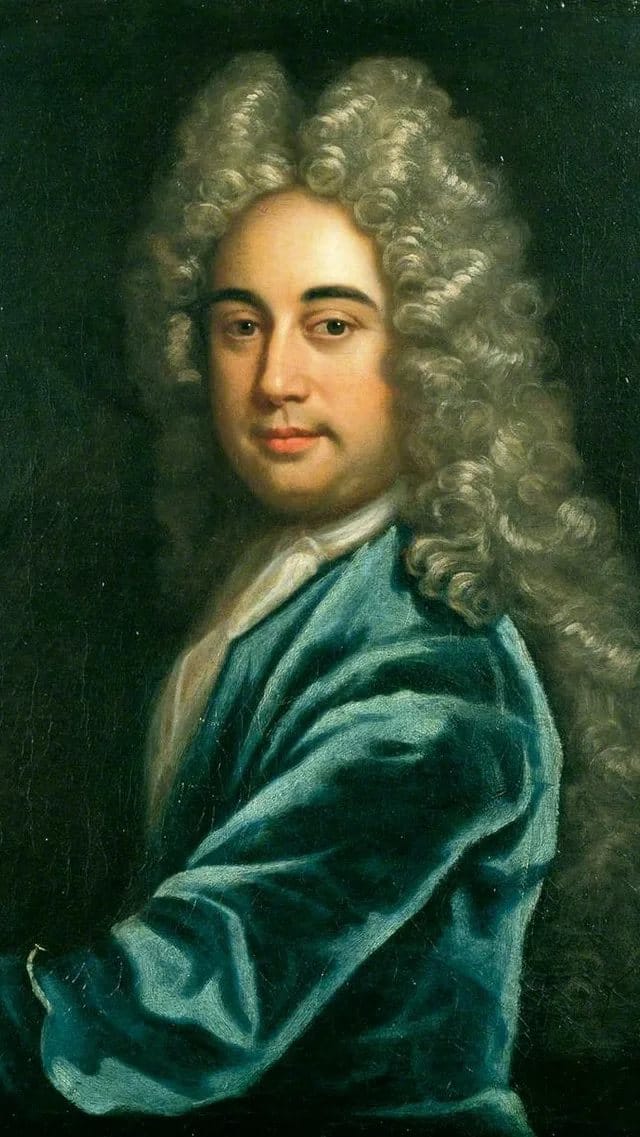
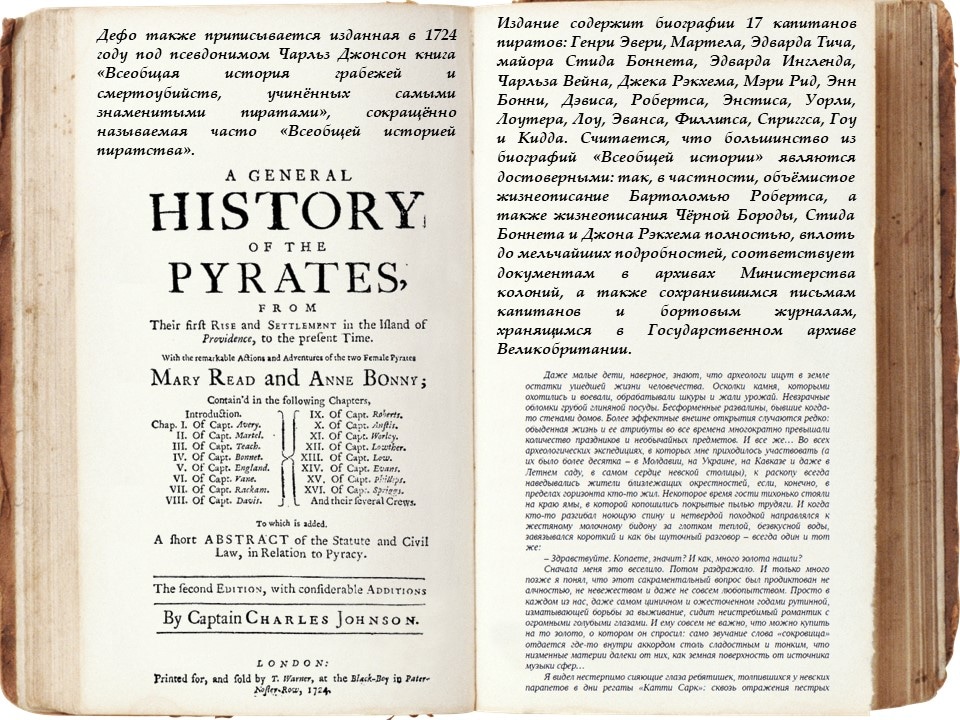
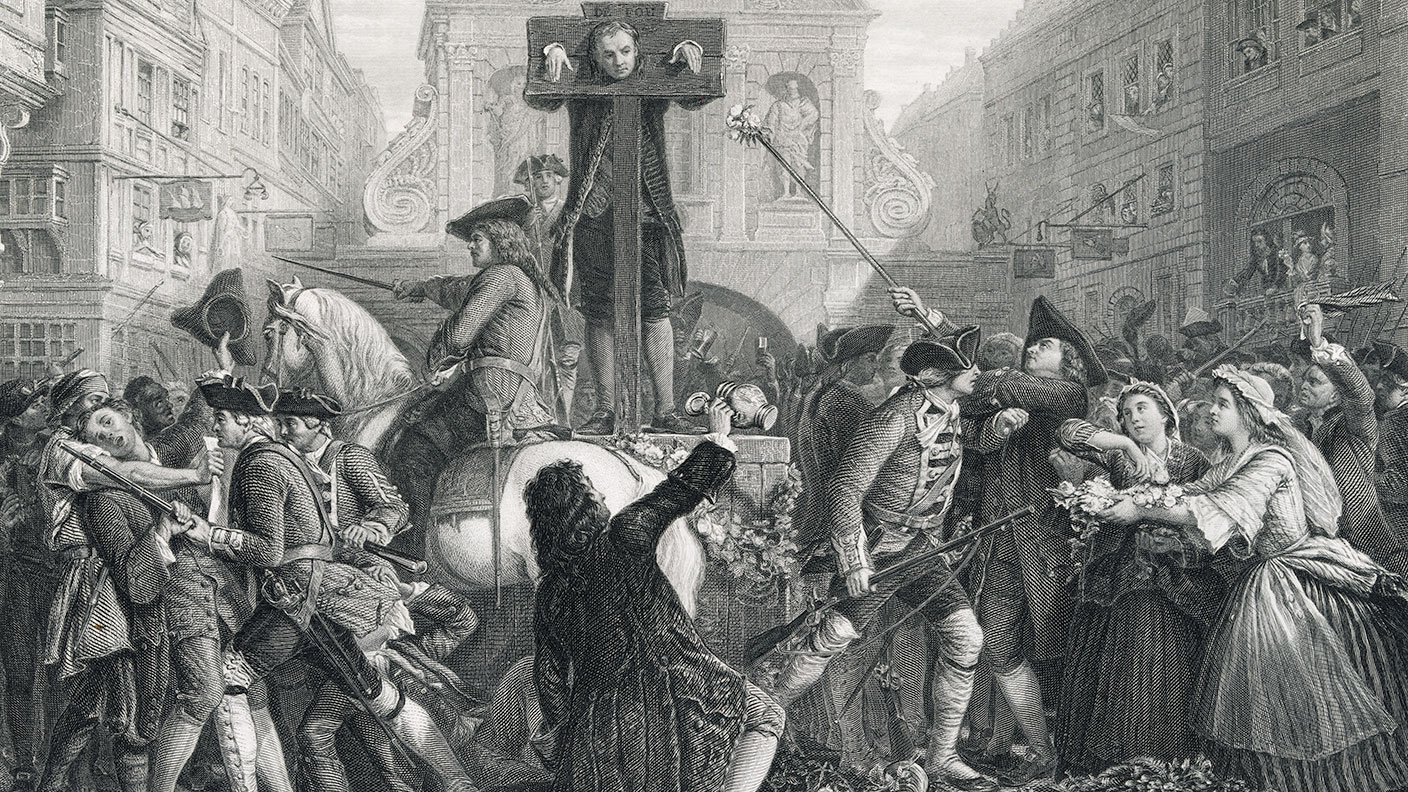

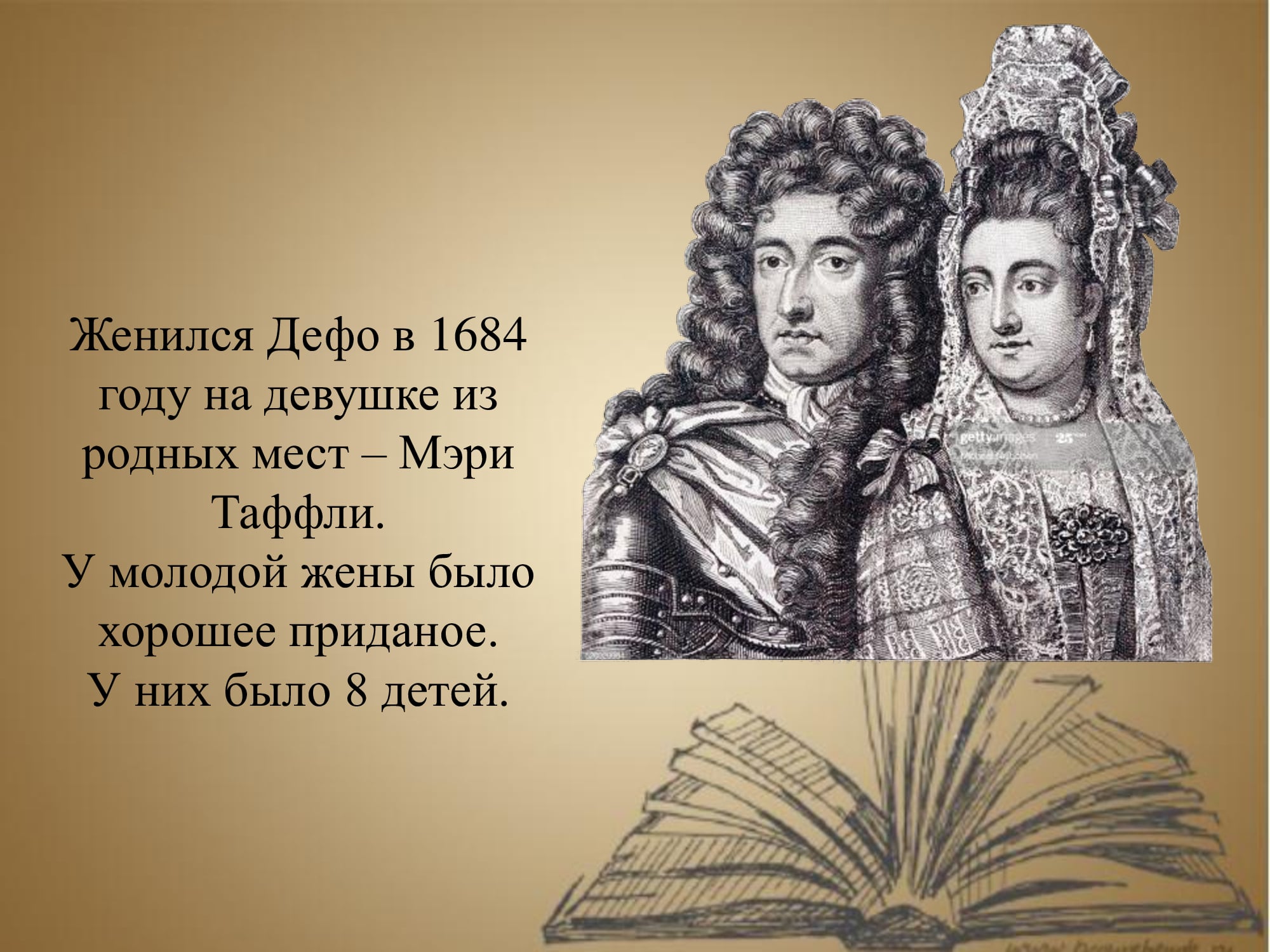
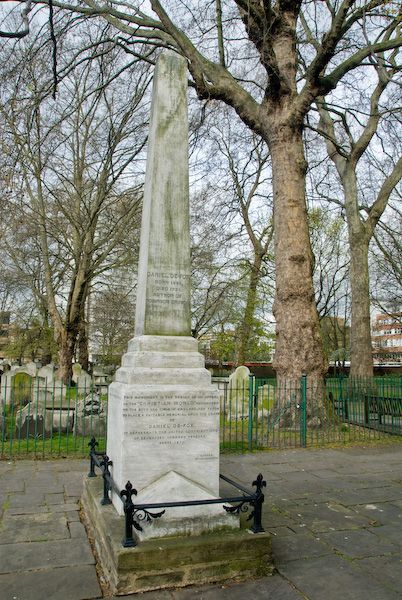
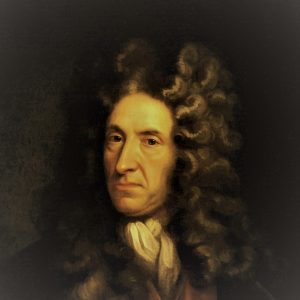 Роль и место в литературе
Роль и место в литературе